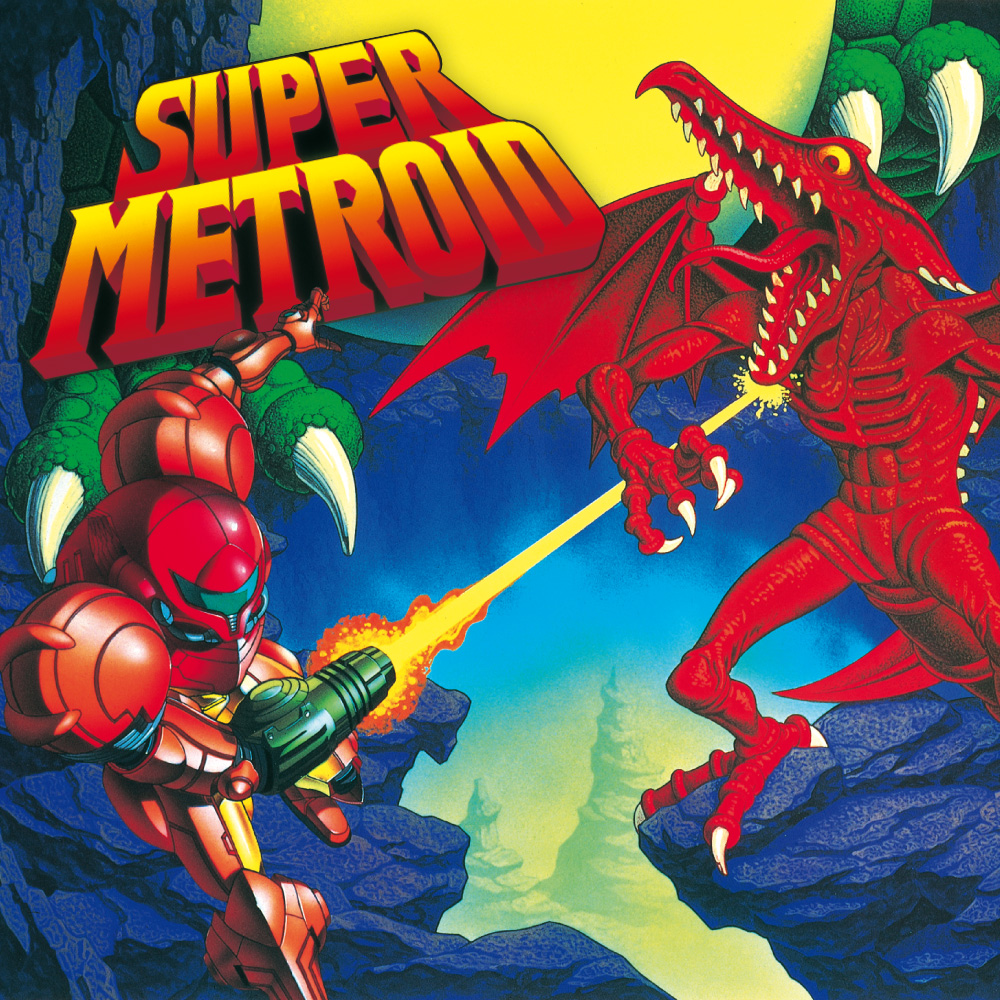
Mythinks #5
The Last Metroid #3 - Super Metroid - Yes, It's That Good
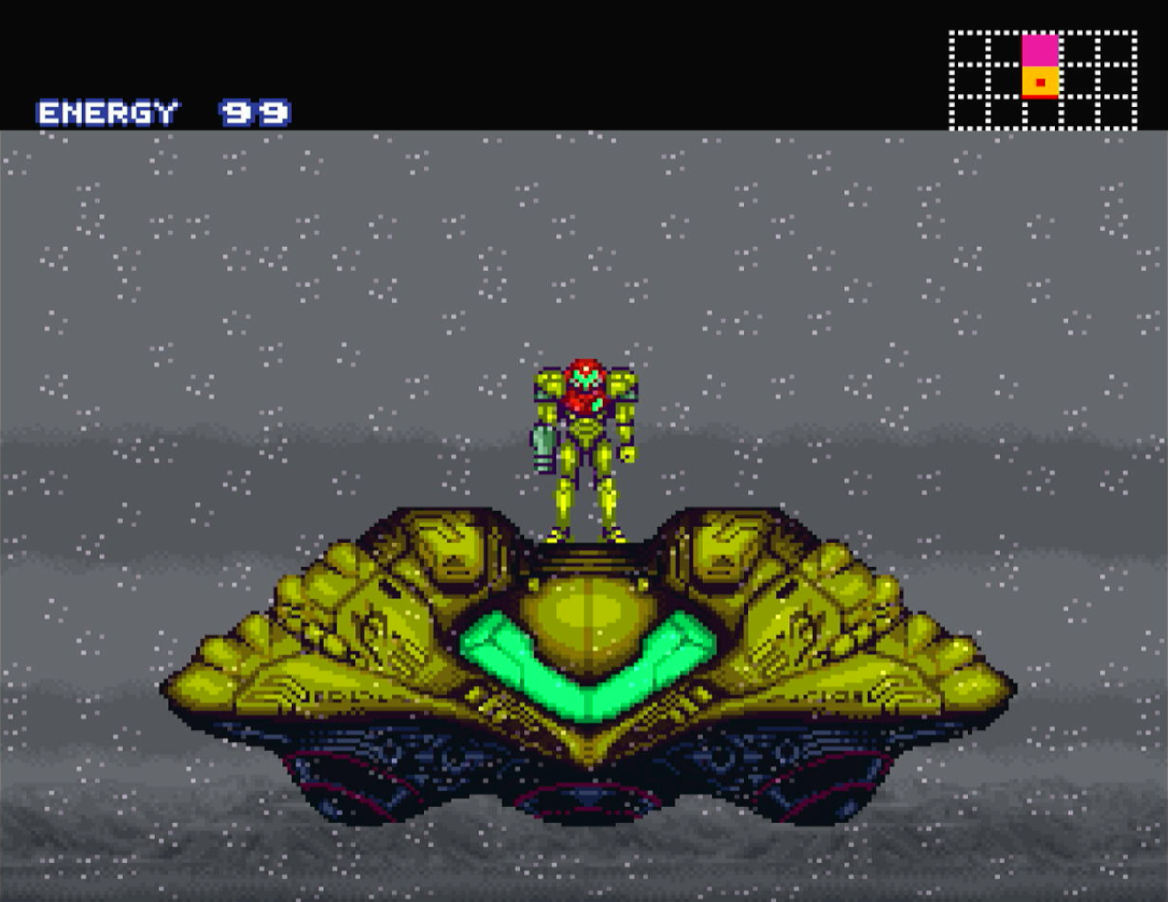
When it comes to writing a review article of every Metroid game, this one is easily the biggest mental doozy, because at this point, what can be said about Super Metroid that hasn't been said before? Well, ultimately, we at Mythinks are just here to state how games make us feel and what makes them so cool, so that's what we're gonna do. We're not gonna try to concern ourselves with "is this just a regurgitation of every other opinion on this game?", in fact we find it best to just go into these trying to not even think about what other reviewers have said about it.
The original Metroid is the game that invented the Itselfvania genre, but Super Metroid is easily the one that defined it to a point where many, many games after it has very direct influences to it. Often times to a point where they flaunt it rather than take any attempt at hiding it, what with the "subtle" references many an indie Metroidvania have made to Super Metroid in particular. It's a game with a legendary status and reputation, no matter which way you slice it.
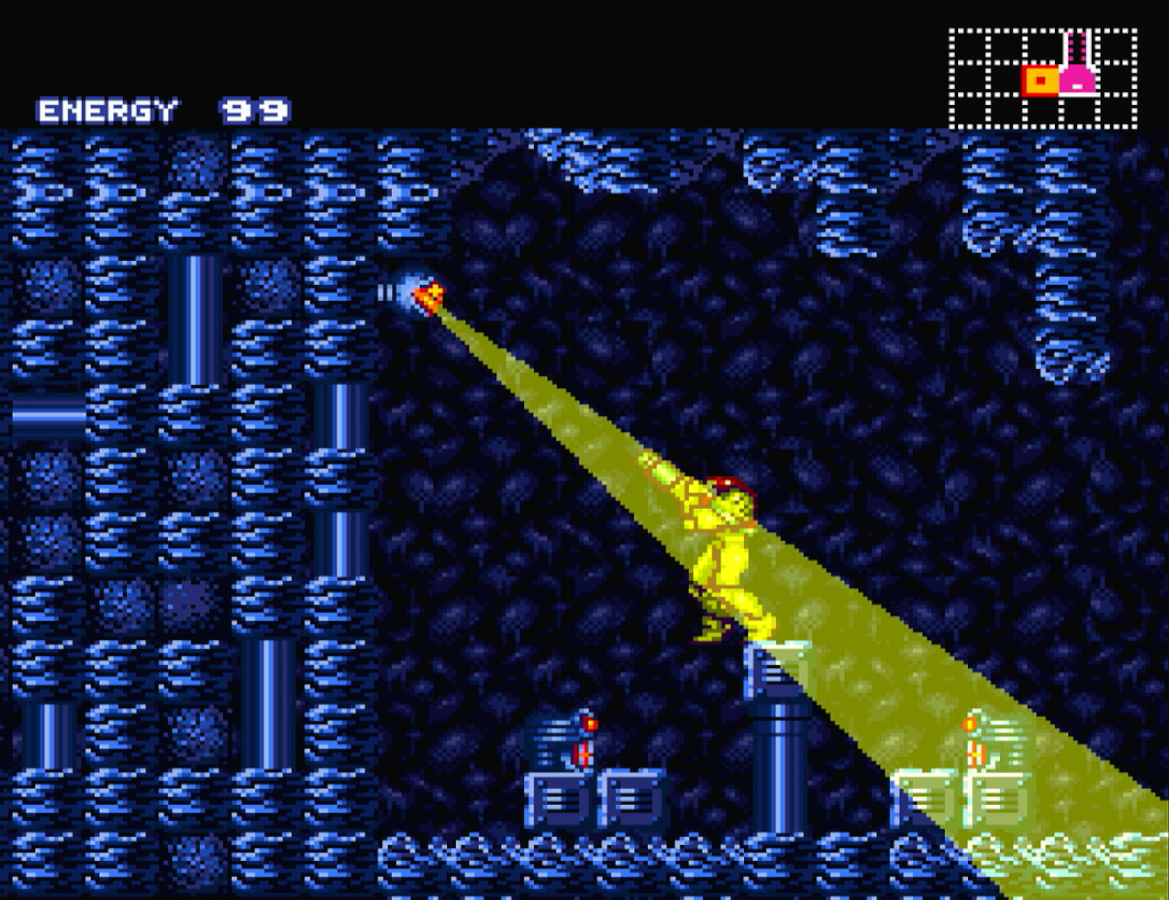
The game itself almost acts as a massive expansion of the original; it's still a continuity sequel, but it once again takes place on Zebes featuring locations and abilities that were present in the original game, but vastly fleshes out the subterranean labyrinth to feature brand new areas that one could say where there all along, just past the confines of Brinstar and Norfair, but weren't accessible simply because they weren't relevant to your mission. This effectively multiplies the size of Zebes by a lot, with several new zones like the Wrecked Ship, Crateria, and Maridia. Even adding a lot of subareas, like the fungal underground jungle now within the borders of Brinstar.
The wild part is that it does this while keeping the original game's open-ended mantra. Of course, the first hour or so of a first, blind playthrough are going to resemble each other a lot. You'll move from Crateria into the ruins of Mother Brain's room, into the familiar part of Brinstar to get Morph Ball, leave to defeat Torizo after getting the bombs, go to the jungle zone of Brinstar, so-on so-forth. But the game slowly morphs into an elaborate puzzle box that only gets more twisty, turny, and begging to be snooped around the more abilities you unlock and the more places you gain access to.
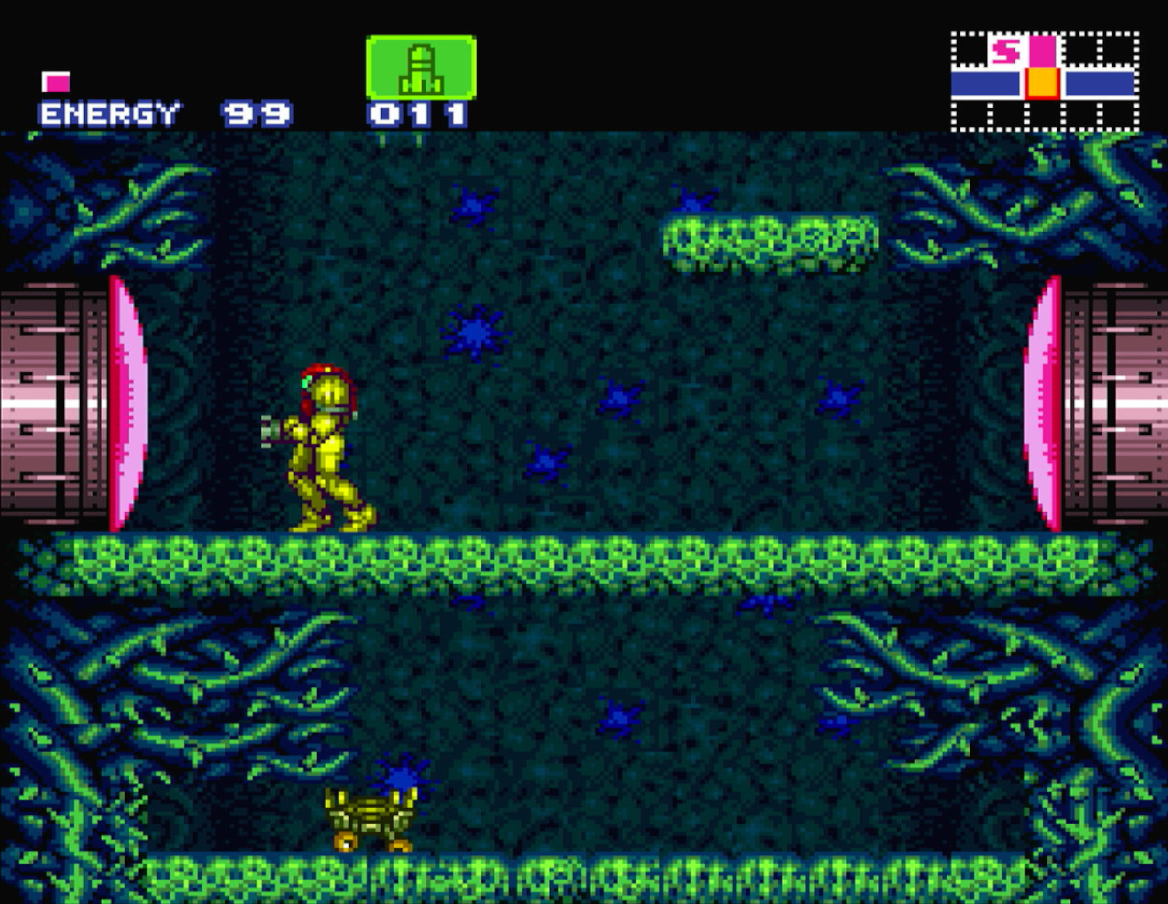
Some of the "keys" are quite literal, with this being a game that doubles down on there being different-colored doors that can only be damaged by certain weapons. We had red doors that could only be unlocked with 5 missiles like before, but now there's green doors that can be blasted open with super missiles, and orange doors that only power bombs can blow up. Plus, this game expands the system of desctructible terrain. That's been a thing since the first, obviously, but this one makes it more overt, and just about any weapon with an explosive property to it has a block type specific to being destroyed by it. So there's just an extra layer of gate-keeping here, one that future games will also find a way to double even further down on.
 IONO:
IONO:
Still holds onto that weird quirk where red doors take five missiles to open, for whatever reason. Be mildly annoying, queen!
-------------------------------------------------------
I think it's interesting how much of what is now the series identity can be owed to this game, essentially. Its progress is much more about puzzling out which direction to go and solving puzzles in individual rooms than both games that came before it. Metroid was labyrinthian, but it wasn't "puzzle-y", if that makes sense. Felt too open-ended for that. And of course, Metroid 2 was far more linear to the point where there's not really any backtracking to speak of, unlike this game where you'll quite often find excuses to loop back to areas you've been in before, but now have access to an ability that unlocks something new in said area you've been in before. The only time that was really felt all that much in the previous games was how the high-jump boots where required to grab the Varia Suit, just chilling in Brinstar. And even then, that was optional.
Most - not all - but most Metroid games after this are gonna be adopting this Super Metroid-y approach, where it's about solving the act of traversal itself, rather than simply having the map and level layout alone be the puzzle. Now more than ever, a Metroid game is essentially one, game-spanning Zelda dungeon.
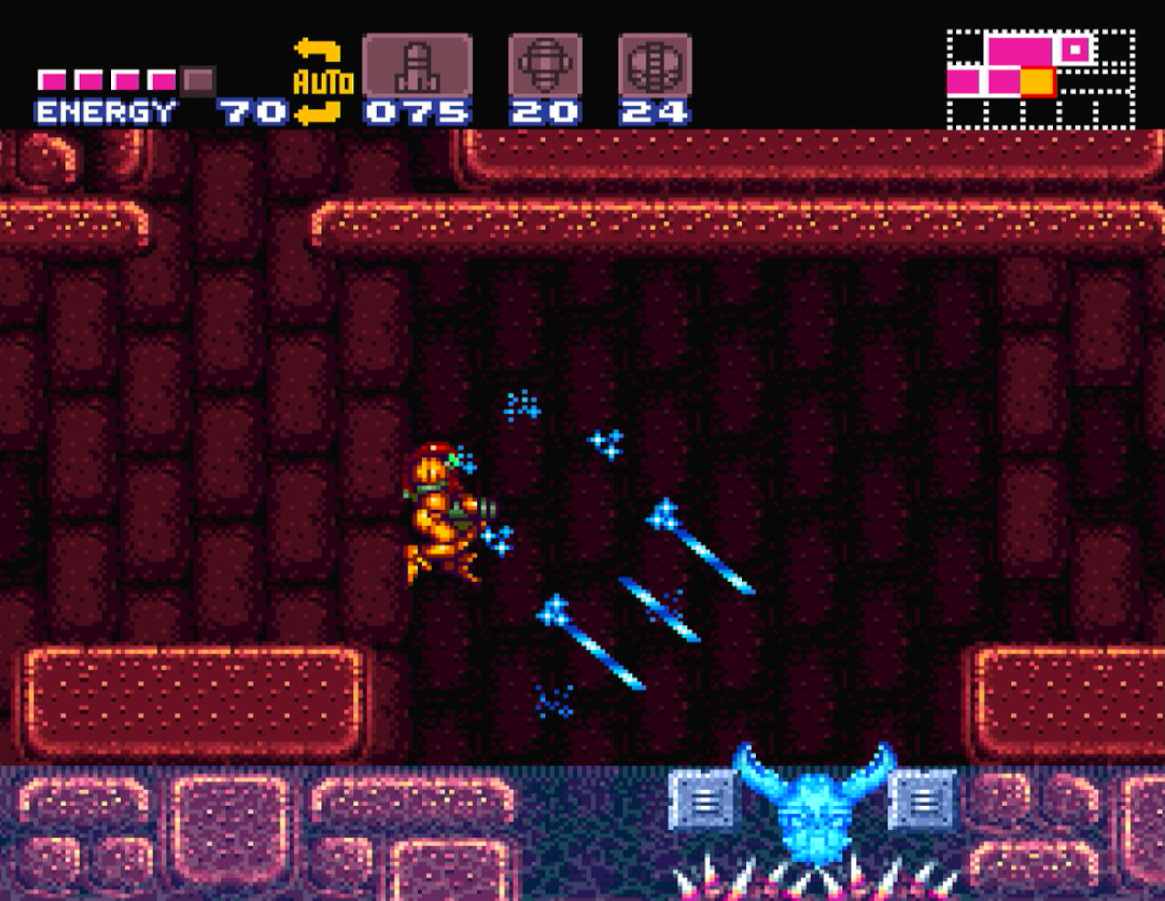
I do think it's this more puzzle-oriented structuring of the game that in part is what made Super Metroid such an influential force. Each ability upgrade is the world blooming outward into an even bigger oyster, you get stuck on a puzzle room with expansion items sitting as a prize only to come back later with the right equipment once you've had that a-ha moment. The exploration aspect of the game has increased tenfold, now having dozens of little nooks and crannies to find hidden upgrades in; barely any items just sitting out in the open for easy pickings anymore. And this game easily beats out Metroid 1 and 2 in terms of sheer number of collectibles, too, so gathering everything is no small feat.
This is wonderous for a genre that operates well on encouraging you to wander, because no matter where you are, there's probably SOMETHING you could be doing to even get a minor upgrade. Even while you're backtracking to an area you've been to because you got an ability that lets you progress in that direction, there's probably a fistful of abilities to grab on the way there, if you're paying enough attention.
In fact, they quite often layer the secrets on top of each other so that when you find one secret room, you'll often get a free item out of it, but then find another puzzle in said room that requires an item you wouldn't have yet, when you can first enter this room, which is once again encouraging you to go exploring with each new major upgrade you get. Something like how in a room in the bramble area of Brinstar, there's a missile tank in a pit that takes little effort to grab, but if only you could outrun the shutters closing, Hmmmmm.
Some of it does come off as a bit of running-out-of-game-real-estate, cause there's quite a few that are a bit "but wait, there's more" moments where you'd swear the secret is found and solved, time to move on, only to realize there was another secret behind the secret, actually. And even one instance of there being a secret behind the secret behind the secret. Jerks.
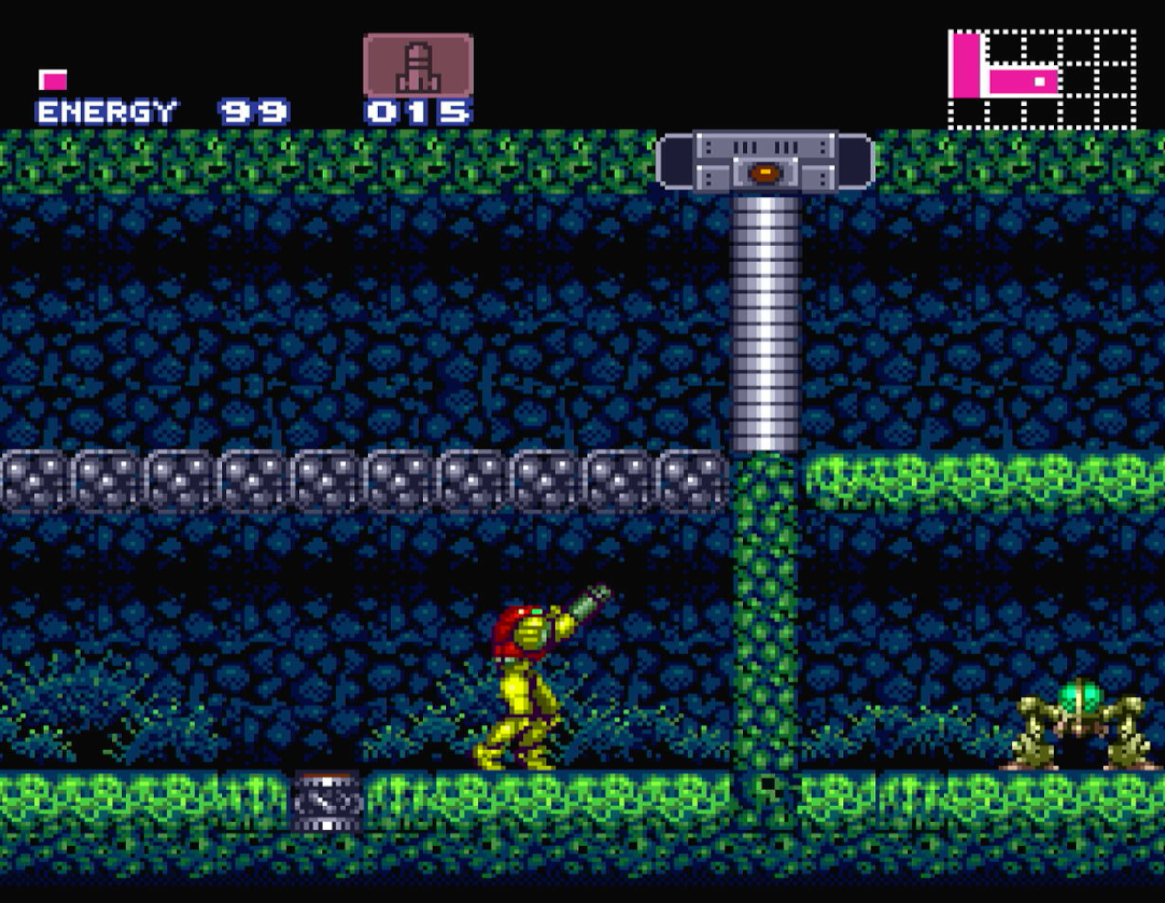
Of course, though, Samus herself comes with a fair share of control tweaks to make the actual act of exploration more of a bliss. And the biggest game-changer in her controls is how you can use the shoulder buttons to aim diagonally! Now we're in business! It takes a little learning to muscle-memory which button aims diagonally up and which diagonally down, but it is a welcome addition and a half. In face, some enemies now feel oddly out of a loop given this newfound ability Samus got ahold of. Skrees were already not that much of a threat, but now you don't even have to stand under them to shoot them.
This game in general does tend to steer far easier than the previous two games. This isn't quite the era where Samus has silky smooth movement (or maybe I'm just a klutz,) so plenty of damage will still be taken, especially from bosses. But later on in the game, after you have a decent stockpile of Energy Tanks and a couple suit upgrades, Samus is just a brick shithouse now, able to take a frankly absurd amount of punishment.
Healing is also easier than ever to do, with not only energy and ammo recharge stations making a return from Samus Came Back, but also enemies, ESPECIALLY the bugs that fly out of the ground infinitely, are just about guaranteed to drop pickups, so aside from a first playthrough, it's not very often I wind up in dire straights. On top of this, Samus' gunship not only heals you, but also refills ALL your stuff, something restock stations can't even do. Yes, this functionality for the ship was in Return of Samus, but there was very little opportunity to ever use it, since it's far from practical to climb all the way to the surface over and over again just to get heals and ammo. Here, her ship is in a location where you'll be passing by it quite a few times per playthrough, so you'll be a lot more likely to actually use this feature.
But back to Samus herself, they also have her a run button. One that thankfully feels a lot better than the usual run buttons where you'll be clutching it at all times because why would you ever let go of a run button. Here, it's MOSTLY to activate Speed Booster and run a little extra fast down crumbling pathways, every now and then. At least most of the time, I'd rather slow it down a bit and walk anyways, though you can definitely make use of the momentum and physics to do funky things with running jumps.
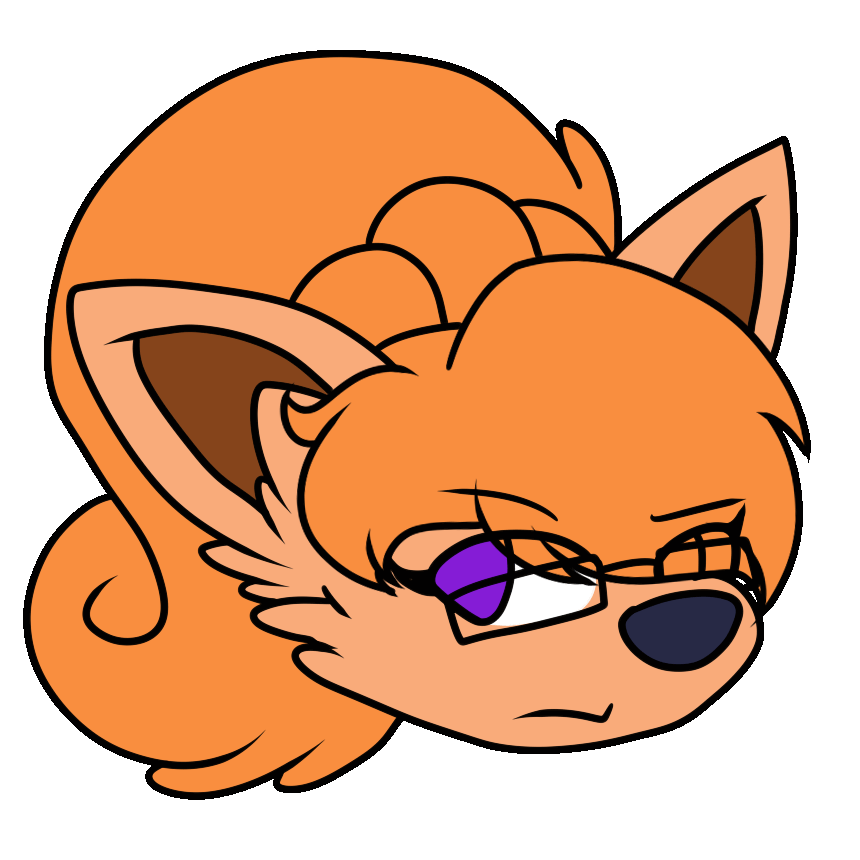 VIXI:
VIXI:
I do feel like the one outright flawed part of this game's control scheme is how you select your different options, which is to say, cycle through them with the select button to access your Missiles, Super Missiles, Power Bomb, Grapple Beam, and X-Ray Scope respectively. By the time you have all five of these items, selecting them gets a little cumbersome. Not enough to ruin the game by any metric, but still a hitch nonetheless. There is at least the Y button to de-select all of them and go back to your normal beam weapon, which is a swell addition. Just for during heat-of-the-moment combat, switching to missiles, let alone super missiles, is a little less than elegant.
-------------------------------------------------------
But before we touch on the more advanced techniques Samus has, let's get into the item discussion, and oh boy there's a lot to cover here.

Bombs:
Like before, we have Morph Ball Bombs again, but this time there's an extra little trick to them that'll be coming back every once in a while. If you time your bomb-laying just right, you'll be able to ascend using the bombs alone quite a bit, referred to by fans as the Infinite Bomb Jump. Nintendo's picky about whether or not this one sticks around, as some future games outright offset the timing to make it no longer possible, while others rather explicitly made Infinite Bomb Jumps possible again.
New!
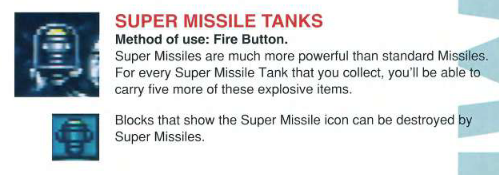
Super Missiles:
The first new addition to the arsenal is Super Missile, which are fairly self-explanatory. They're missiles. But super. Lower fire rate, and there's less of them overall, so they're a bit risk-reward as an outright weapon. They take a bit to nail, but when they do connect, it deals a ton of damage.
New!

Reserve Tanks:
After you collect one of these, while you're full on energy and you collect more, you'll fill up to four Reserve Tanks that will trigger when you take would-be fatal damage, healing you up based on how much energy they have stored in them, a bit like a cross between Mega Man X subtanks and Zelda fairies.
Interestingly, Super is the only game to use these. Why exactly, who is to know, though it might have something to do with how you don't get to see them take effect very often, if at all. Which is funny, considering I find plenty of future games after this one far more difficult than Super, so you could actually benefit from a Fairy, but alas.
New!

Charge Beam:
This is an easy one to take for granted, but, yeah! Charging your beam weapon for an attack that does extra damage is a new thing as of this game. It understandably just becomes a part of the standard moveset for most games after this. It serves as a way to defend yourself against the missile-only bosses, as a charge shot will damage them as well, though I still think a better solution to that would be to just make bosses susceptible to normal beam shots. Missiles just feel like they aughta be a resource to deal extra damage rather than outright be the only weapon most bosses in this series are vulnerable to.
This game loves its items with multiple functions, and Charge Beam is one of them! If you hold a charge and then do a somersault, you'll basically get a miniature Screw Attack and do contact damage to the first enemy you collide with. I can't recall how often I've used this function, but it's there!

Hi-Jump Boots:
Maybe it's the screen real-estate after playing Metroid 2, as well as a bunch of wall jump tricks you can do, but hi-jump feels way more noticeable in this game.

Varia Suit:
Varia Suit does what it's always done; double defense. But now it comes with that one function I've not been secretive about at all! This is the game that introduced superheated rooms, areas (most of Norfair, basically) that are so hot it damages you just being in them, but the Varia Suit completely nullifies that damage! It does make it another "key", essentially, the dynamic of the superheated rooms isn't complicated. In essence, the idea is you gotta stay out of them. But it is one that adds extra texture to the world, really selling Norfair as a lava-filled cave system.
New!
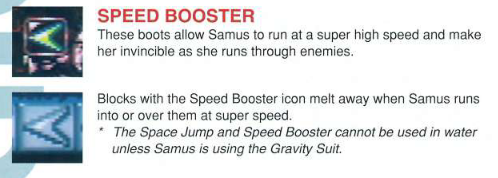
Speed Booster:
Another new item in the mix, and easily one of the most versatile and conceptually coolest abilities in the entire series is the Speed Booster. With this, if you run for long enough, you'll keep accelerating until you reach screeching speeds and plow through obstacles and enemies like they were nothing. And they do all sorts of neat things with the Speed Booster, like a few spots where they teach you that you can use the momentum from the speed booster to really take some flying leaps.
And that's not even half of it. A less obvious function of the Speed Booster is what would eventually be referred to as the "Shine Spark". If you duck while speed boosted, you'll convert that speed into a power-up state where pressing jump and a direction will send Samus flying in that direction, draining her energy for how long she travels. It's a tricky trick to get used to, but can be very gratifying to pull off, as well as pull some shenanigans with it.
New!
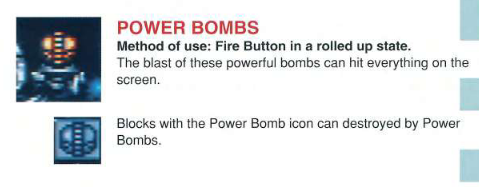
Power Bombs:
Missiles got a "super" variant, so Bombs also got a supped version of them. Unlike normal Morph Ball Bombs, Power Bombs have ammo, but it is also a screen nuke that blasts the whole area after a second to arm itself. You'd think this would be busted for combat, and sure, it kills most common enemies. But it's mainly for blowing up certain walls and floors that hide goodies. Perhaps in that regard, their inclusion feels a little anti-climactic, but hard to argue with a screen clear.
New!
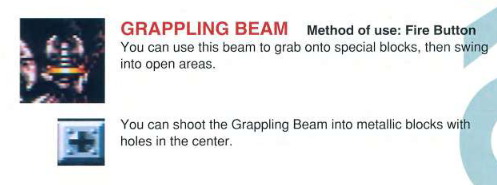
Grappling Beam:
NOT one of the common beam weapons, despite the name. It's just quite literally a beam that allows you to grapple onto certain hook targets and swing from them. The swing physics are funky, and I almost never feel like I'm using this one as intended, just hugging the ceiling and grappling short distances. More like the Monkey Bars Beam. If nothing else, it's funny to find a random grapple point in the middle of the air and just swing circles around it.

Ice Beam:
Speaking of beams though, let's just rapid-fire shoot through the collection of beam types. Charge Beam was the only outright new addition, but the function of a few of these beams has actually been decently overhauled. Ice Beam now only freezes enemies on the last hit that would have been lethal, instead of alternating between frozen and not-frozen, which at least makes them feel a lot better to shoot with. Otherwise, Ice Beam is Ice Beam.

Spazer:
Spazer hasn't changed much since Metroid 2, it still turns your beam into a wide shot spread. So I'll take this chance to note that this game gives the beams the biggest overall overhaul in that they all stack on top of each other now! No more having to juggle with one you prefer or having to switch back to Ice Beam to finish the game! If you have Ice Beam and then receive Spazer, the Spazer effect just gets added onto Ice Beam. Game changer!

Wave Beam:
Previously, Wave had the ability to pass your shots through walls before that got taken off and moved over to Plasma Beam. Well, it's back on as Wave's primary effect, again. And it'll be staying on as Wave Beam's primary effect, even in the 3D Metroids to a degree.

Plasma Beam:
The Plasma Beam's new effect is that it allows your shots to pass through ENEMIES, easily mulching groups of smallfry that would normally take a bunch of shots to mow through.
New!

X-Ray Scope:
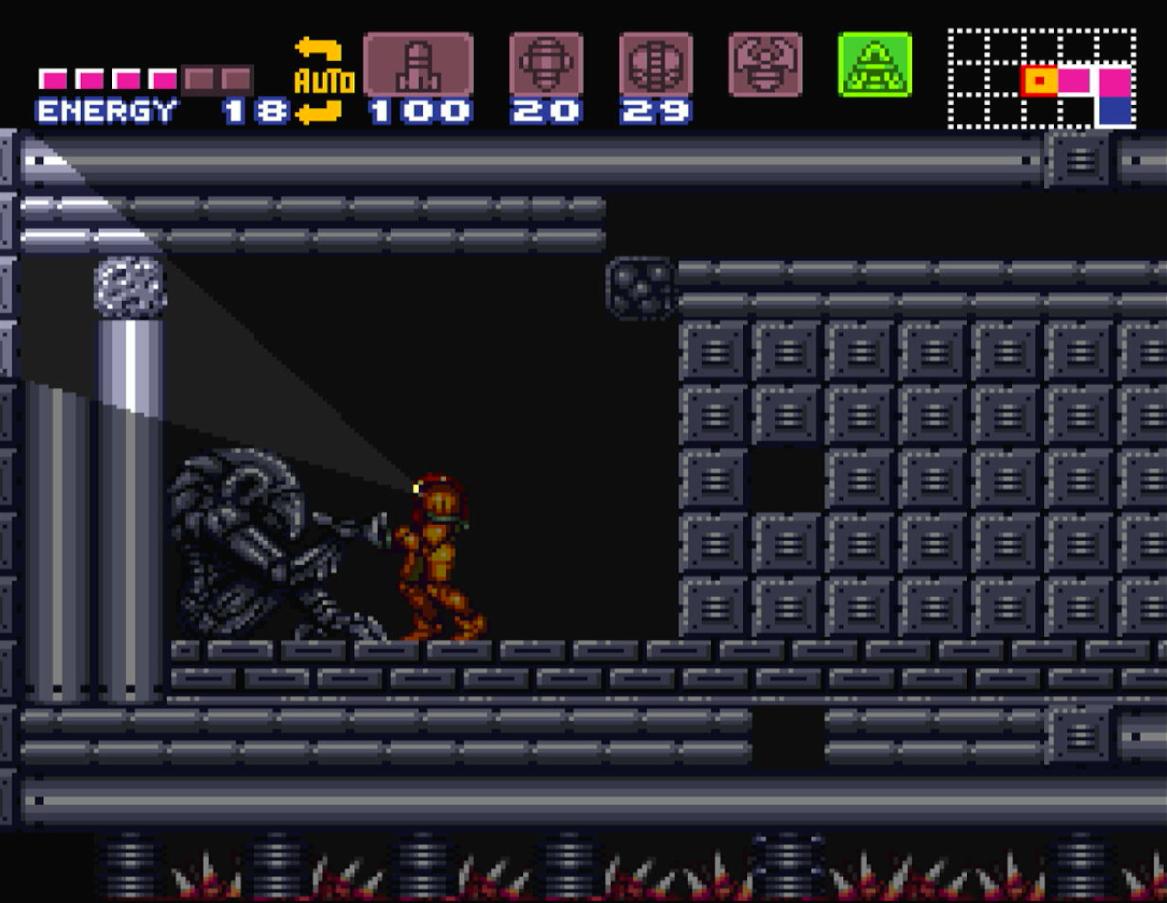
This upgrade is pure utility and scouting, allowing you to stop in place and scan the area with a cone of vision to reveal what blocks they're made of, as well as hidden passages. Surprisingly enough, this item's never come back, at least not by name. Certain items in future games serve more or less the same function, but I honestly feel like X-Ray Scope is the best way they've pulled off a "reveal the environment around you" type of ability.
New!

Gravity Suit:
Varia's no longer the only suit upgrade! Metroid 2 also had small amounts of water in it, but you couldn't do anything about it. Gravity Suit not only doubles your defense yet again, but also allows you to move freely through water as if it was open air, and boy is this ever a freeing ability to grab whenever it is available, cause moving through water in this game is (by design, obviously) a chore.
And as an extra bit of spice, this suit also lets you fully submerge yourself in lava. Boiling acid is still off the table, though. Sorry, boiling acid enjoyers.

Spring Ball:
You get this much later than the previous game, so its presence is a little less felt, but it still feels good to be able to jump as a ball. Whee.

Space Jump:
Back from Metroid 2, Space Jump is still far from perfect, but feels notably more responsive in this one than in the previous game. It also comes with a much more obvious visual tell, adding animation speed smears to Samus' somersault sprite. As well as just spinning faster, in general. She must be getting dizzy in there.

Screw Attack:
Once again we end on Screw Attack. Does what it's always done, though obviously with the improved Space Jump it hurts even more.
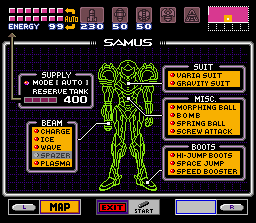
Something that I've always liked and missed, since it's never returned in future games, is actually the ability to toggle your, well abilities. Like sure, functionally there's not much point to it, but the fact that it can be done is interesting. Plus you get to see what each beam weapon on its own looks like, especially since Ice Beam turns your beam blue no matter what.
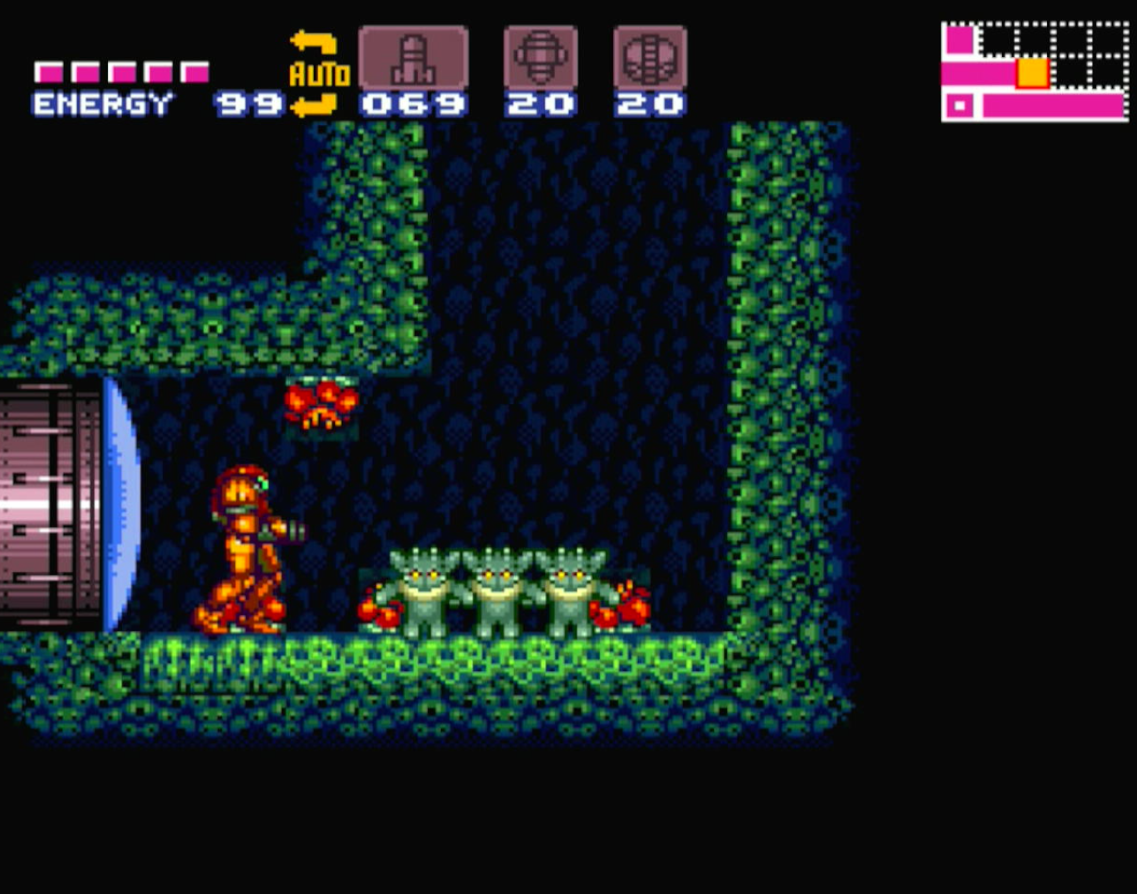
But arguably one of the biggest additions to her moveset in series history is the hidden ability to wall-jump. You don't need an item to unlock this one, it's just innately there, and the timing can be tricky to figure out. So much so that there's a section of the map where they trap you down a hole with alien monkeys and wall jumps being the only way out so that you REALLY get the timing. It's not as obvious as, say, Mega Man wall-jumping where you just stick to the wall and jump off of it. Here you have to hug a wall while doing a somersault, and then pull away from the wall, which will cause Samus to enter a specific "kicking off the wall" animation, which is your window to hit the jump button again to bounce off of it. It's weird to get used to, and on a first-ever playthrough I got really stuck down the etecoon hole.
Of course, the purpose of the wall-jump isn't entirely clear, since it's both just plain part of your moveset, and also isn't outright required at any point. But what it does offer is a solution to one of those mysterious asterisks I left up there, earlier. On paper, High-Jump Boots are required to reach the Spazer, but in reality, you can use your ability to wall-jump to get it notably earlier than you're supposed to. The wall-jumping is essentially the game endorsing sequence-breaking so long as you have the skills with that wall jump.
You can use the wall jump in a number of different ways to cheese the game and get a decent number of items far earlier than intended. A pipe in the overgrown Brinstar area is also normally only reachable with the high jump, but thanks to wall-jumping, you can get the missile tank inside of it. With a lot of skill and stubbornness, you can ascend the shaft in red-soil Brinstar with the wall jump where you're normally meant to ice beam your way up some Rippers in order to get Power Bombs far earlier than normal. Wave Beam before getting Grapple Beam. In particular, I like to at least try to pull off a tricky wall-jump in the bubble area of Norfair to access a room normally only reachable via Grapple Beam, but you get a fistful of goodies like a missile, energy tank, and reserve tank for the trouble.
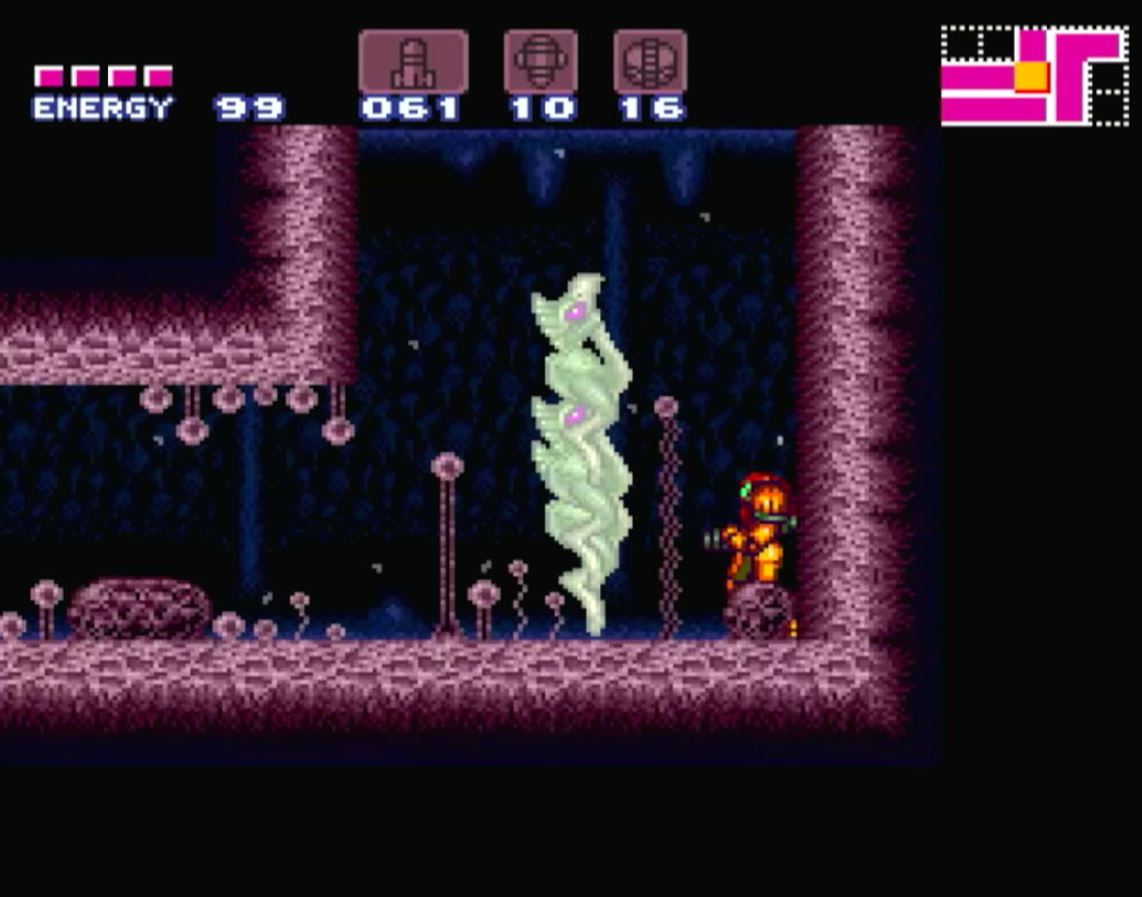
It's easy to get too speed-boost happy and fall into a pit in Brinstar, which brings you to the Dachora, which will then cycle over and over the motion of shine sparking, telling you to crouch while speed-boosting in order to then propel yourself upwards and out of this otherwise inescapable pit.
The Shine Spark is also an opportunity to cheese certain areas, as you'd expect with an ability to just starkly travel in one direction with only walls to stop you. My main use if it is to grab a missile tank hanging out on a cliff meant to be reached via Grappling Beam, but I just shine spark up there cause it's way easier. But with the right kind of finesse and finagling, you can also use it to enter the Wrecked Ship before you even have Grapple Beam at all, allowing you to grab Gravity Suit early if you want it.
It's just plain impressive how much movement tech is in a game I often hear the movement is one of its flaws. Sure, Samus herself moves like an oversized pickup truck in a cramped parking lot, but her moves are still consistent. Later games obviously sand off the edges to make Samus control silky smooth, and that's wonderful in its own right, but I don't think it's fair to discount this game just because Samus has a bit more weight to her in this one. Which is saying something for a girl that so often acts like gravity is a suggestion. The game still hands you plenty of tools to forge your own path, and hell, find new paths on repeat playthroughs.
Well, at least until you start getting better mobility upgrades. By Space Jump, you don't really need wall jumping anymore, but it's definitely a cool gamer party trick to show off a sequence break or two. What's most brilliant about it is how, again, it's not required for anything. It's purely for finding spots where you can break the game wherever you so desire.
I think it's pretty cool to have full endorsement from the devs to just snap the game in half, so long as you have the skills to do it. Which of course, gets into certain tricks that I'm not even good enough to pull off consistently. "Mach Ball" is a minor glitch that allows you to preserve running speed while in Morph Ball form, its most notable use being in that "how do I outrun the shutters" room I mentioned earlier, which actually nets you an early Super Missile upgrade, allowing you to skip Spore Spawn completely if you take THAT sequence break and use it to break even more sequence by doing tricky jumps and threading the needle through the exit hole that you normally first get Super Missiles from.
 VIXI:
VIXI:
That is where so much of Super Metroid's magic comes from, why I so often think about playing it just because I'm bored and no other game is coming to mind. I dare not internalize what speedrunners do because I'd rather find these weird ways to get stuff you weren't meant to on my own. It's one of those games where despite playing it all the way through probably over a dozen times by now, I still find at least one thing new about the game that I didn't know before, however minor it is. Can I make this jump just by doing a gigantic speed booster jump? Not quite, but almost. It's a game where you just try shit to find out.
-------------------------------------------------------
Side note since this isn't about the game itself, but randomizers and archipelago only accentuate this by forcing you to figure out how to traverse certain spaces with item sets you weren't meant to have. Having to traverse Maridia with Gravity Suit, but no High Jump, let alone Space Jump, for example. Speedrunning has a "reverse boss order" category, for crying out loud.
I don't think this game even sacrifices that much in terms of weird random discoverable things. There's definitely more mandatory abilities, especially when playing the casual, intended route, but you can beat the game having never found Wave Beam or Spring Ball, among others. But that also leads me into talking about the world of Super Metroid itself.
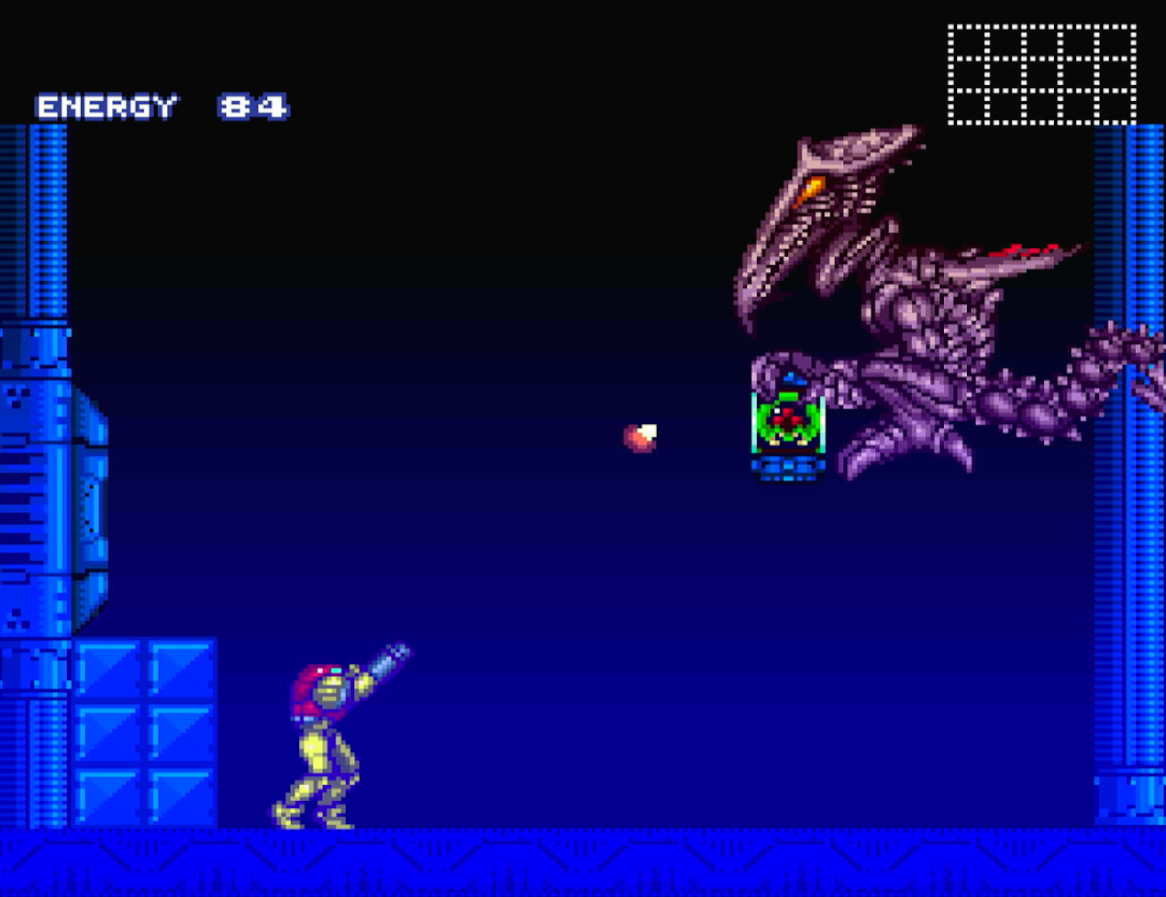
The story once again picks up right where the last game left off. After purging the Metroid population on SR388, Samus takes the last surviving larva Metroid and gives it to some science hippies that are studying its ability to absorb energy or what have you. They say this is for the betterment of mankind but I guess we'll just have to take their word for it. The previous game didn't first-hand feature the Federation in any way, but curiously we're already at the point where the Galactic Federation has turned human-centric.
Naturally though, almost as soon as Samus leaves, the space colony Ceres gets attacked by Ridley, so Samus has to u-turn her ass back there to try and stop him from kidnapping the baby Metroid, but no matter what, Ridley managed to get away and Ceres station self-destructs. This is the Metroid universe, of course it self-destructs. Obviously not content with leaving it there, Samus pursues Ridley back to Zebes, where the Space Pirates have rebuilt their fortress.
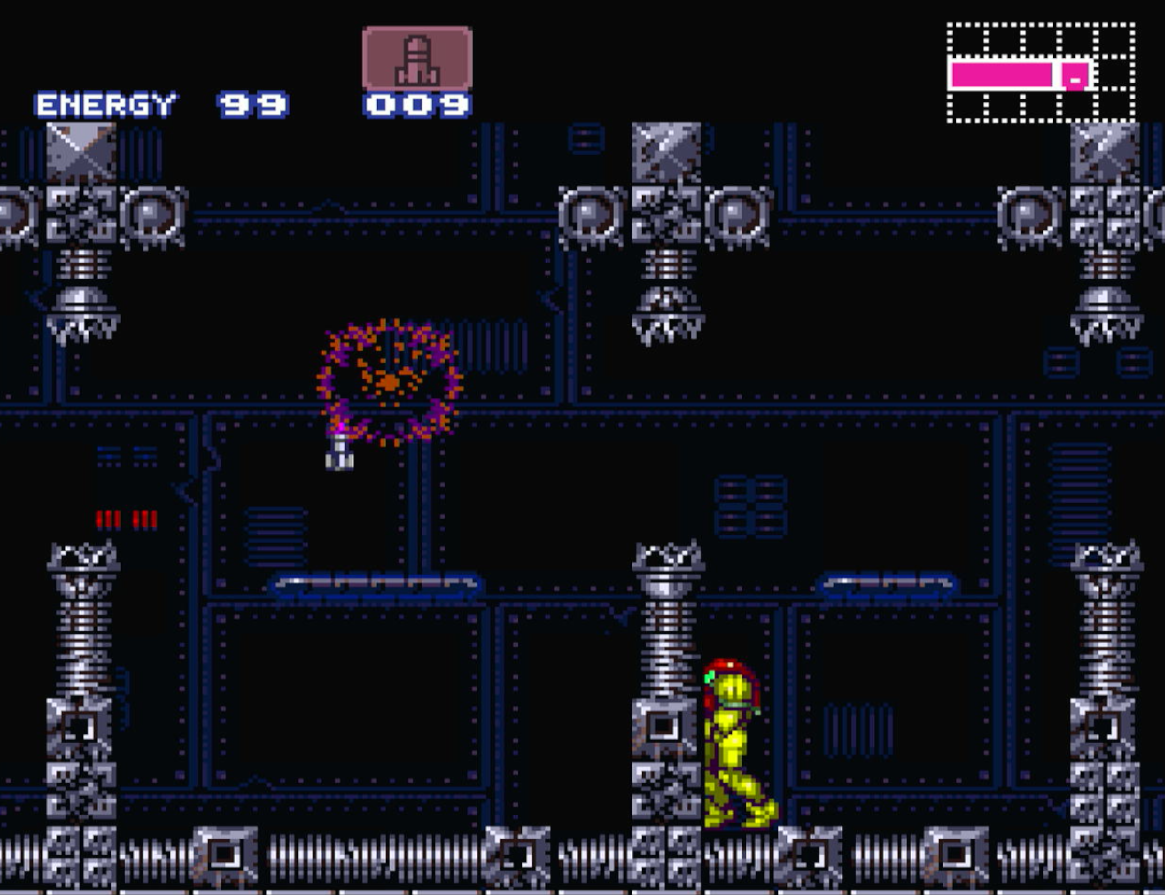
Zebes, as stated, has gotten a major facelift. Norfair and Brinstar are still here, and you even explore the ruins of old Tourian, but the game has vastly expanded the Zebes map to a point where it's still almost essentially a completely new world. There's now an explorable area that's on the surface, called Crateria, though it's more like a transitional hub between most of the other major areas. The new Tourian's entrance is also here, and they obviously upped security; the door is now locked with the life force of not just Ridley and Kraid, but also two new guys, Phantoon and Draygon.
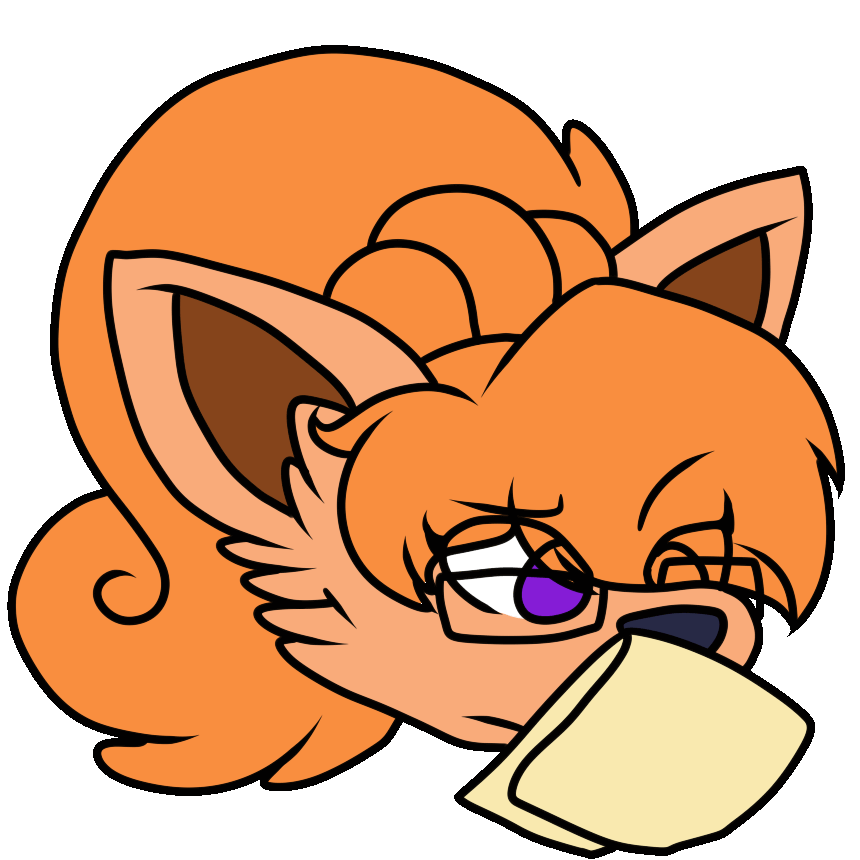 VIXI:
VIXI:
Actually. Weird aside. Are Phantoon and Draygon "Space Pirates"? Ridley is without a doubt sapient, and Kraid is perhaps questionable, but like. Surely Phantoon and Draygon can't be directly affiliated with Space Pirates, right? Phantoon is a supernatural apparition and Draygon's just kind of an animal defending her litter of Dragonlings. How does this door remain locked until they've been killed? Video games, that's how.
Not that it's a huge deal for "breaking the lore" or whatever people get mad about these days, it's just an oddly gamey detail in a world that feels kind of real and lived-in, otherwise, so that sorta thing just sticks out to me for some reason. Zebes perhaps has an unrealistically complicated cave system, but it nonetheless fills out out with a lot of cool wildlife, each area almost never settling on using another biome's enemies, at least for the most part.
-------------------------------------------------------
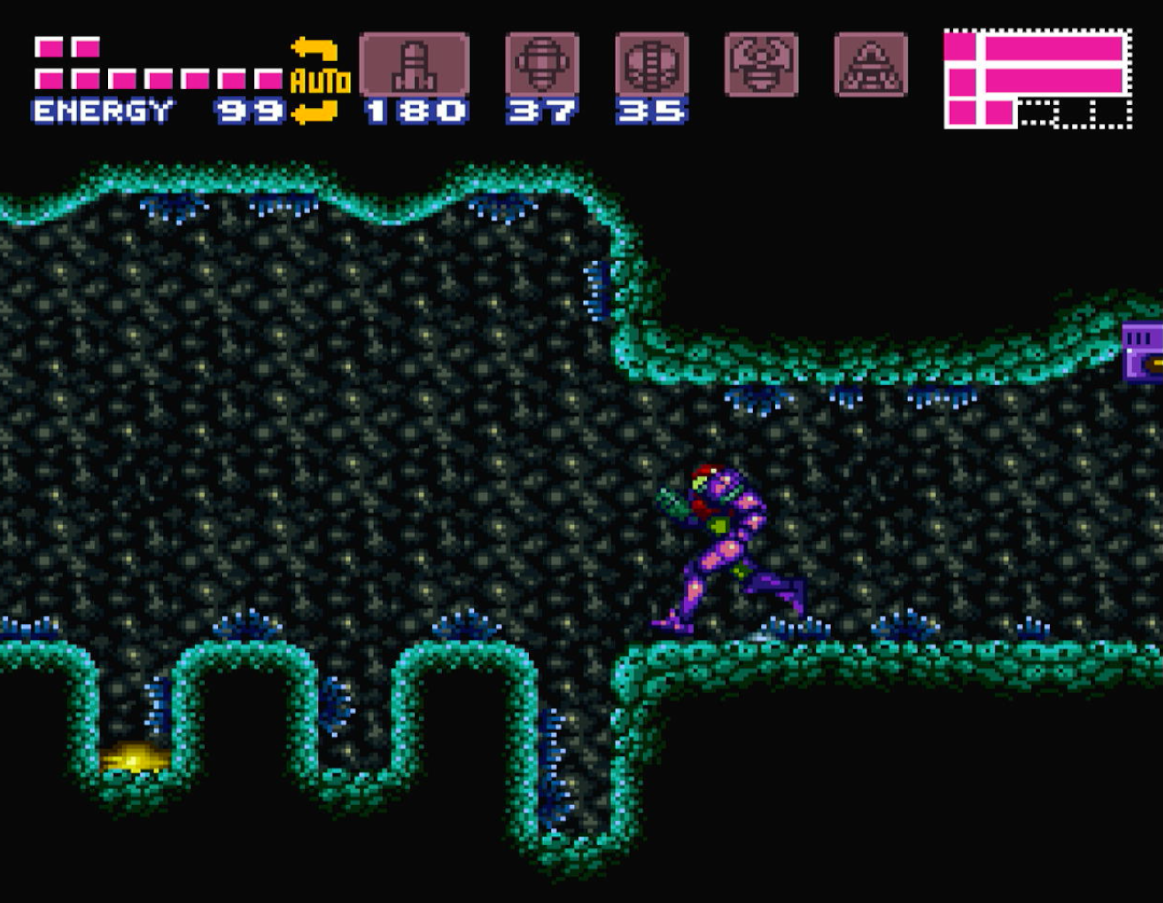
Each area's biome is also quite distinct without having such harsh borders that it feels like you're playing Minecraft. Maybe that's not a tremendous deal these days, but for 1994, when video games were still very very video games, where you had your grassland level, cave level, ice level, fire level, and so-on, it's pretty novel to see a relatively small chunk of a planet be at least somewhat realistically diverse while not being so diverse that the game will hard-cut to The Water Level out of left field. The Wrecked Ship is one of the ways you can enter Maridia, and as such the Wrecked Ship is surrounded by and partially submerged in water. While red-soil Brinstar is far from "the fire level", it still compliments being next to Norfair by being, well, red. On top of this, the upper layer of Norfair doesn't have a ton of superheated rooms, but naturally the deeper down you get, the warmer it gets until you eventually reach Ridley's lair. Which is just, hot forever.
This doesn't even sacrifice each area feeling very distinct from one another. I'm probably familiar enough with the game that I could play Super Metroid geoguesser. As opposed to Metroid 1 which had so many copy-pasted rooms that you could only guestimate for the most part, and Metroid 2 which had areas be somewhat homogenous.
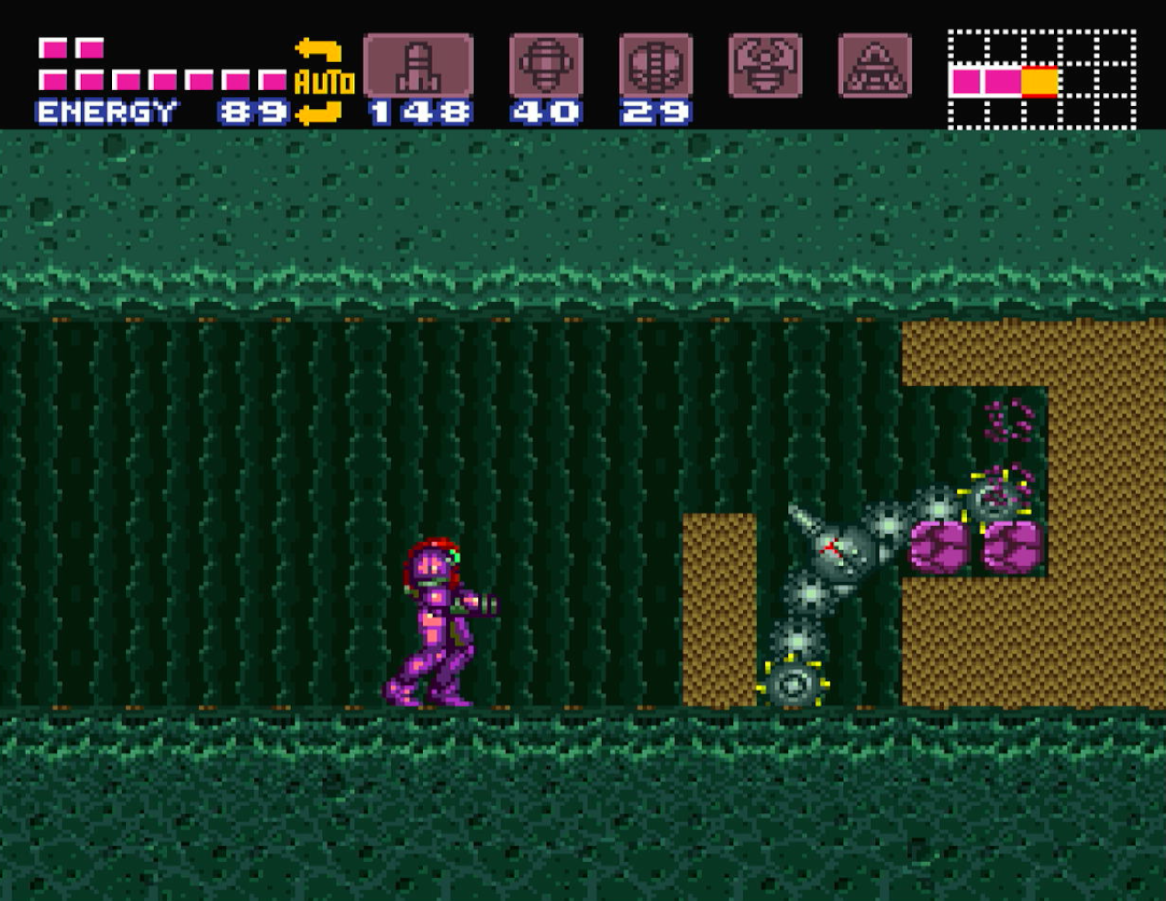
Hell, on top of this, even individual rooms are distinct. Each area in previous games had their own sets of enemies, sure, but you'll very often have elements that are just unique to a single room and appear nowhere else in the game. The Etecoons and Dachora are two things, but you'll also have a room with a mama turtle defensive of her young or a silly little drilling robot that exist in a single optional side-room and nowhere else in the game, which only makes the game even more rewarding to discover. I can only imagine what this game must've been like before you had the internet to tell you everything about a game before you even got a chance to play it. Was Metroid popular enough to elicit playground talk? Were kids telling their friends "Yoooo dude if you blow up a wall worm in lower Norfair there's a giant ridley head and an energy tank behind it!!"?
As usual for this franchise so far, Super Metroid can be prized on its impeccable atmosphere, and this game is among the best in the series, in that regard. The dank energy of Maridia is unforgettable, with its darker, more drab color palette, and its mysterious music track backing it as a confusing underwater maze. I particularly enjoy how the wrecked ship, in a lot of ways mirroring a haunted pirate ship wreckage. The power is shut down the moment you reach it, but defeating Phantoon restores power to the ship, kicking the machinery and robots into gear again. I think it's neat how said power outtage effects even things like the Save Station and the Map room, these things not functioning until you put the power back on.
By extension, the soundtrack is one of the series' very best. Not a lot of it is overt or jaunty like the first game or the surface theme of Metroid 2, but I think that willingness to be a little more lowkey is a thing that helps make its individual tracks stand out more. The underground jungle area of Brinstar has a music track that stands out more when it's the only track in the game that's catchy and energetic quite in this way. Only heightened by the way the game introduces you to this music; the slow-fade in being perfectly timed for the first elevator ride into this area.
The wetland area of Brinstar has a theme that feels so very foreboding, but also serene, to a point where it's become a little legendary in its own right. The "depths of Maridia" theme, as I've stated, feels fitting for how oppressively hard to navigate that place is, especially if you manage to get in here before having the Gravity Suit. And of course, Lower Norfair is a fantastic track to build up your final confrontation with Ridley to, it being one of very few outright "action" tracks in the game.
For a game that's as hands-off in terms of its story content as Super Metroid is, it feels like a good move to let the world in and of itself be a story, with the depths of Zebes really changing its own relationship to you over time. You even permanently changing it in a few ways, like the aforementioned Wrecked Ship segment, or blowing the glass tube connecting Brinstar to Kraid's Lair open with your power bombs. I think that's the core ingredient that makes Super Metroid so good at what it does, by being so rewarding to the naturally curious.
Of course, what this does is gives incentives on not only future playthroughs, but also your current one to use your newfound movement tricks to find weird tricks and get to new heights you couldn't, before, like I stated with me getting Spazer earlier than you're meant to.
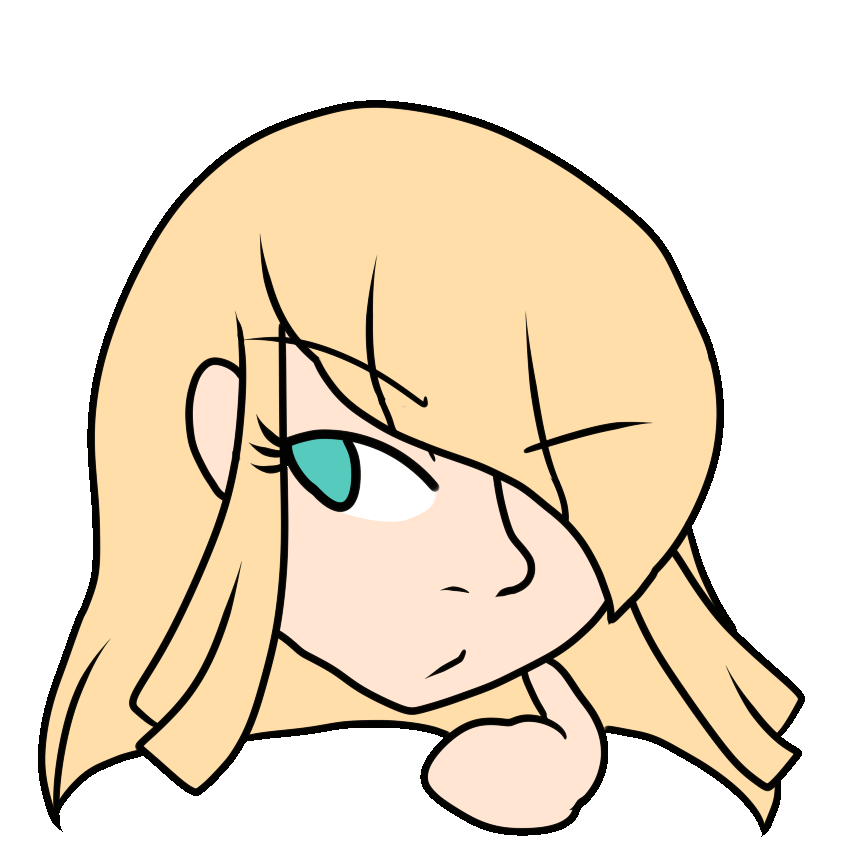 CELESTE:
CELESTE:
As Metroid is going to move more and more into a heavy-handed guide-by-ability-keying-everything approach, I do think some of them miss out on having more soft keys, compared to hard keys. Hard keys, of course, being whole abilities that unlock new areas overtly, and soft keys being innate abilities that you can use to get to places maybe even the devs didn't know you could get to. Not that I don't recognize the risk of the latter, because it certainly opens up the possibility to getting soft-locked into places more, especially in 3D games, but that still doesn't change the fact that future Metroid games feel at least a little less freeing to route yourself in.
-------------------------------------------------------
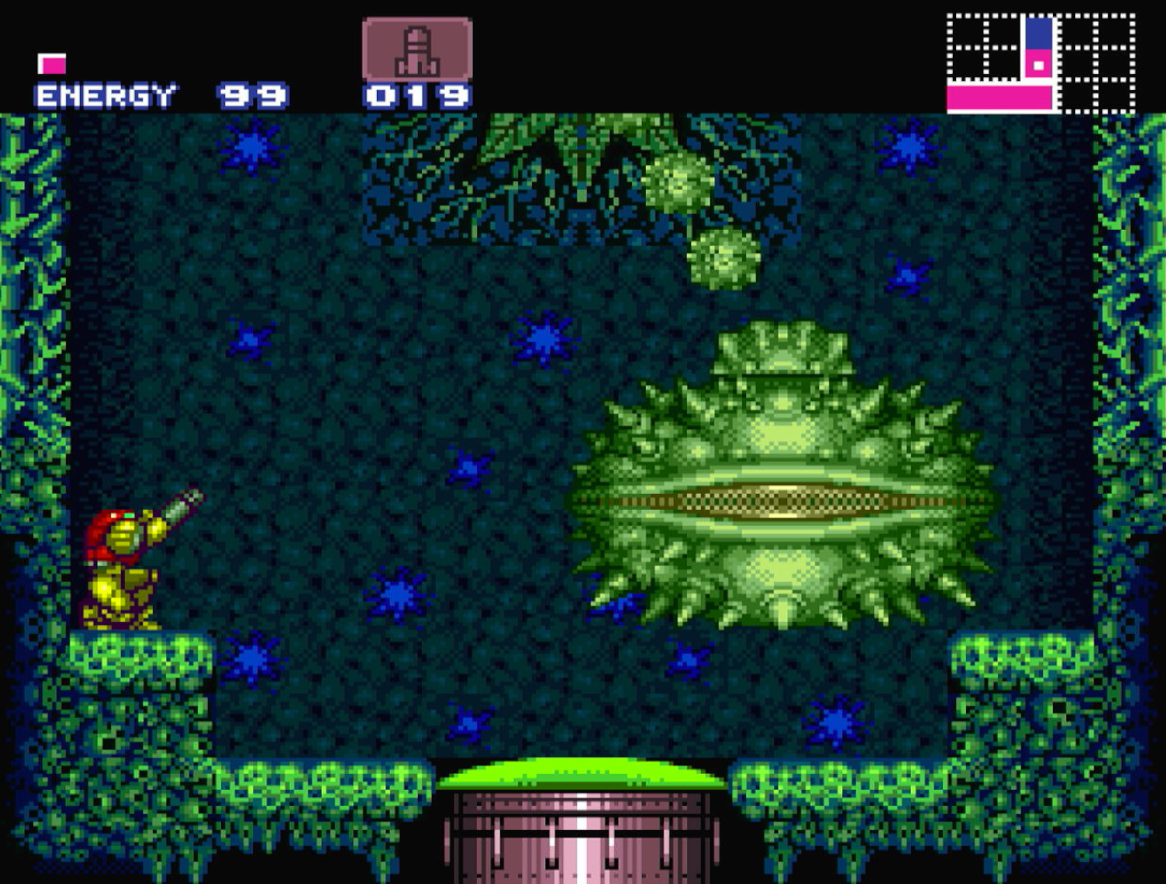
While the bosses are far from this game's highlight, they do feel far more distinctive in this game than either of the previous ones. Torizo as one of the item-bearing statues come to life to fight you being a cool subversion of expectation, possibly even putting some new players on edge for when or if they're gonna pull another one of these out to surprise you. Which, they do, but again, not in a way you'd expect.
Spore Spawn is pretty often mocked for being boring, but that first blind playthrough can feel like a vibe check with how much it asks you to keep track of. Kraid gets easily the biggest glow-up, quite literally, with them blowing the guy up in scale quite dramatically. I can only imagine what it must've been like to be a kid when Metroid 1 came out to boot up Super Metroid when it was new and see Kraid's giant mug raise from the ground, only to then rise even further. Him being so big he's literally impossible to fit onscreen all at once.
Botwoon... gets an attendance award. Hey, they can't all be bangers. The poor guy even gets left out of the game's manual, when it mentions every other area's miniboss.
Draygon may not be wild on its own, but easily one of the coolest aspects about it is the hidden quick kill you can discover. I'll keep that one a secret, at least, because I felt galaxy brained when I... found it by accident while button mashing.
![[REDACTED]](https://file.garden/ZdVgHDYfNDjNIcph/Mythinks/The%20Last%20Metroid/Super%20Metroid/SM%2015.png)
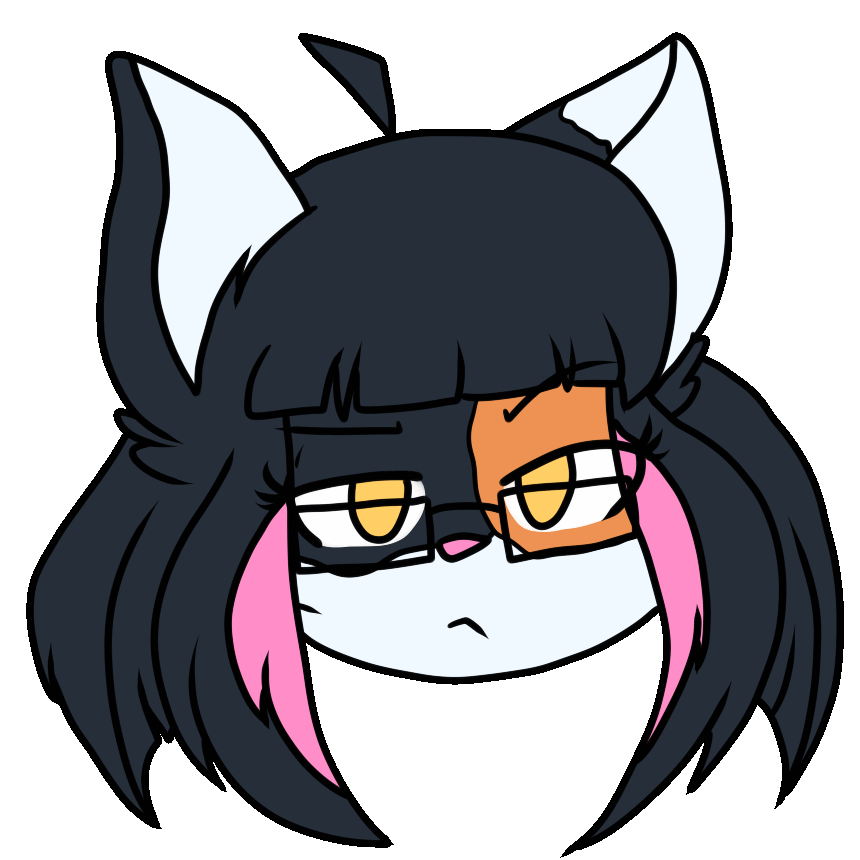 JINX:
JINX:
combat isn't exactly this game's focus, i would say, but it still very much feels like the first two games, where boss exchanges feel more about trading damage than actual mastery of a boss's attack pattern. not helped by the way they hog so much of the screen space. this is, again, offset by how non-lethal damage gets at a certain point in this game, but it still feels a little cheesy and unearned to beat a boss by tanking all of its attacks to the face. it's not until future 2d metroids that i think the bosses feel fair but also punishing instead of. unfair but unpunishing...?
-------------------------------------------------------
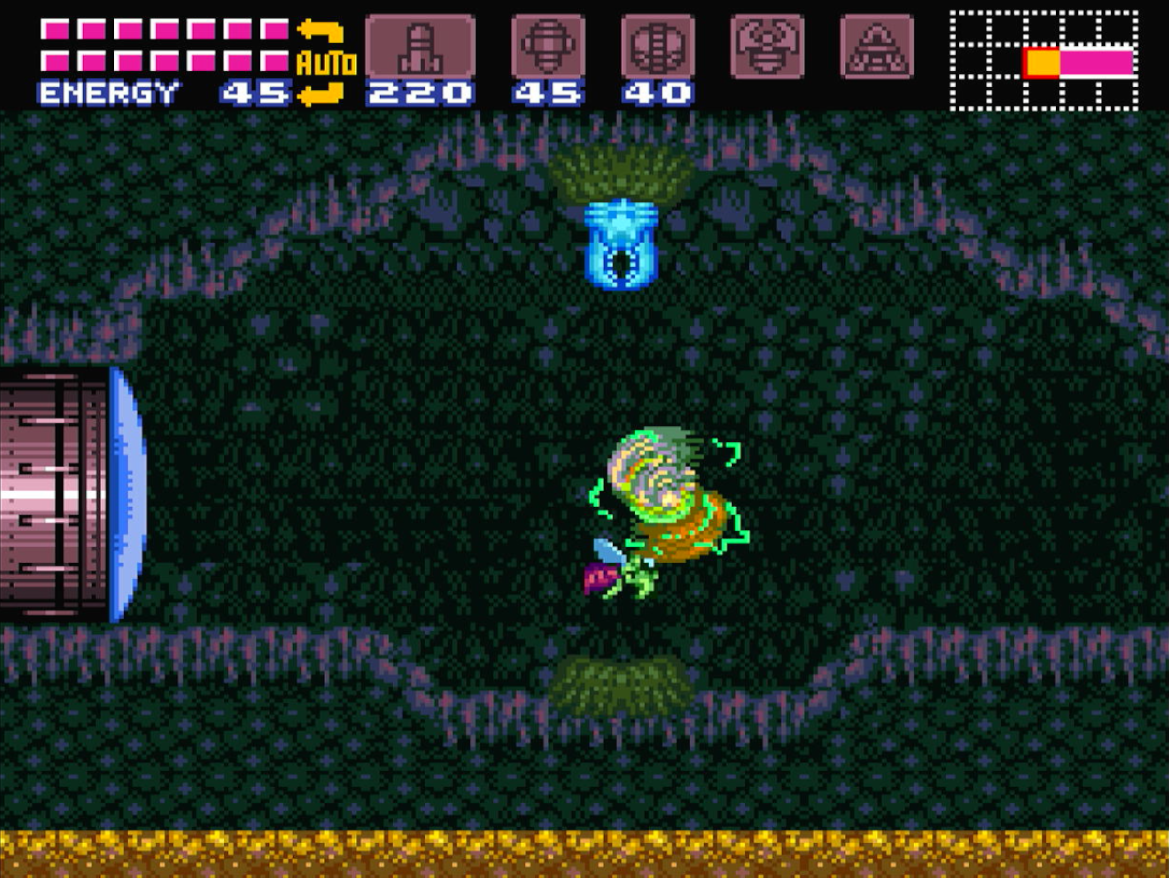
Each area of the game goes through its own respective loop of mastery, where even Maridia begins to feel more trivial to traverse once you have the Plasma Beam and Space Jump to help you move about the place. That feeling of breaking out from underneath and oppressive atmosphere being a big help when hunting for secrets in that area. With maps now being a feature within the game itself, it permits for these more confusing layouts, since players will have a layout more on-hand. Not that the map is perfect; it has dots to point out secrets in some of the rooms, but not all, and it doesn't make obvious how these rooms and halls connect, so you'll still have to make mental note of all that.
By the time you've picked up your last ability, you can blast through the whole planet, this once oppressive place now more like a playground. It seems like no coincidence that Ridley is on just about the opposite end of the map from Tourian. It's practically an invitation to take one final lap around the world, collecting every last item you can get ahold of. Or for the repeat players, pick up anything you know you've missed.
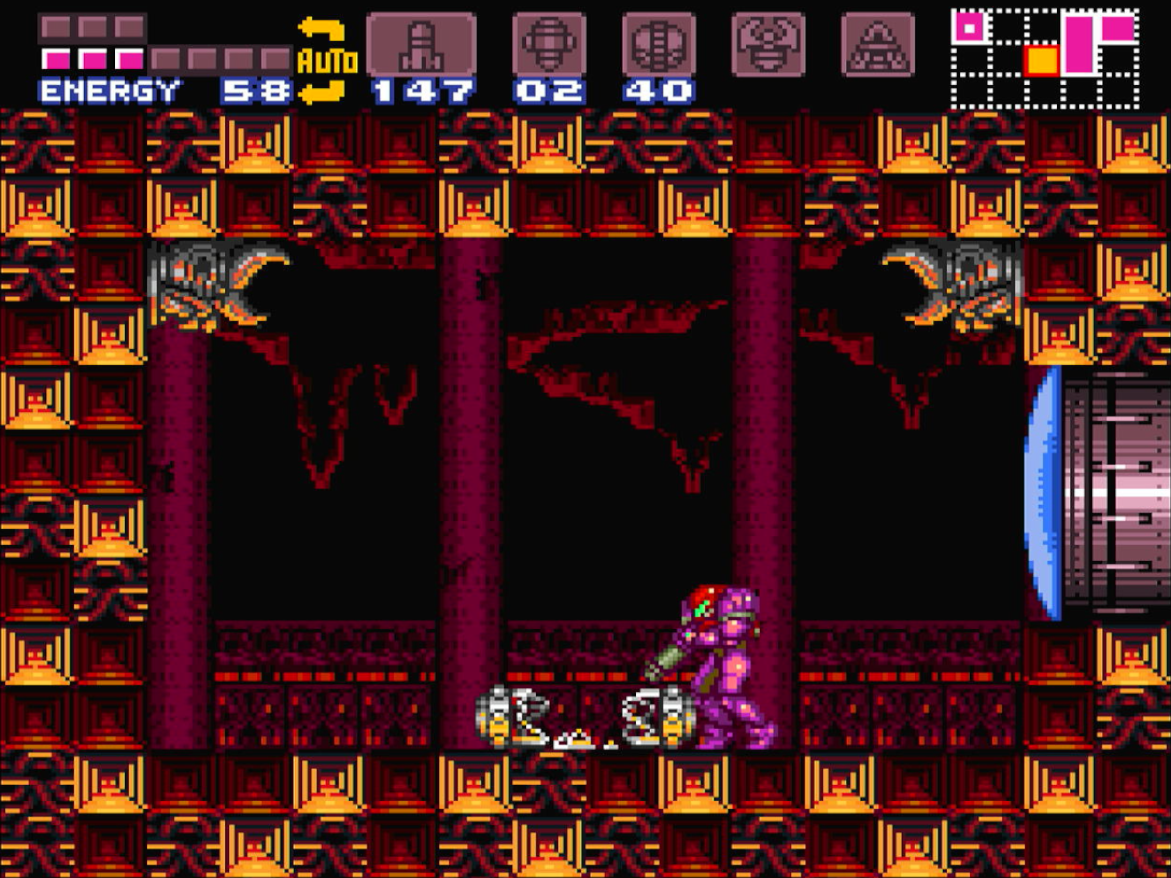
Speaking of, I also enjoy how much this game is almost essentially a revenge path to get to Ridley, only to arrive at Maridia and find some failed Metroid clones there. By the time you get to Ridley himself and finally defeat him, you enter his room not even to find a final item, but just the cracked and broken container this Metroid hatchling was in. Like Ridley put it there to get the last laugh had Samus defeated him.
This eventually takes you back to Tourian, where you are lulled once again into something familiar. Basically bookending the game between two major Metroid 1 callbacks. You fight Metroids and the spaghetti-O shooters, just like before, but that seems to only serve to ease you in with something you've done before, if you've been playing the series up to this point.
...Because then, they throw the curveball of having a Torizo and various other creatures sucked so dry, they just turn to dust the moment you touch them. There's new sidehopper variants that are virtually invincible and are just better off avoiding, at least until you're cornered by one. The game then doing basically its best to jumpscare you with a giant Metroid so big that it can't be frozen with the Ice Beam. Unless you're a speedrunner, you're bound to get caught by it, except it'll stop as you're on your very last leg, whimpering and flying away.
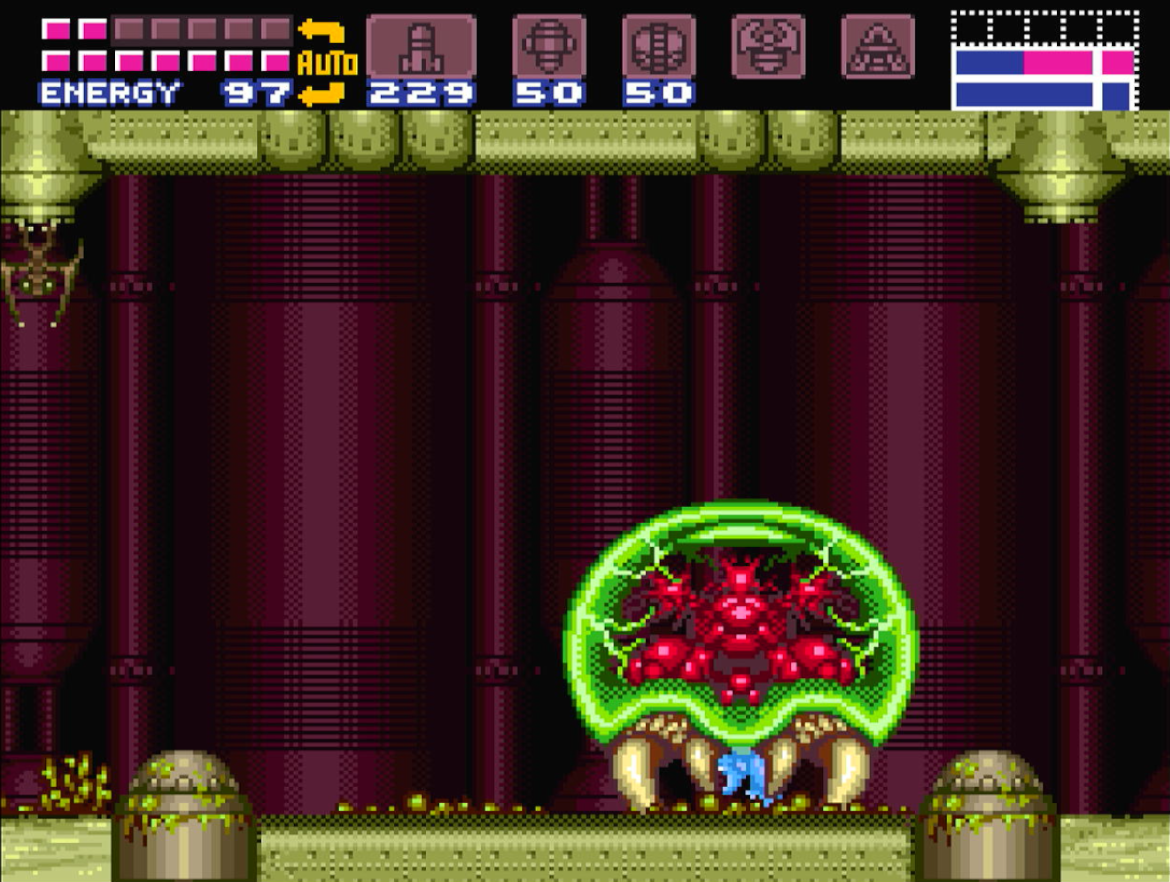
The finale of Super Metroid does a fantastic job telling a story within the framework that is Super Metroid. All of it without cutscenes, let alone any dialogue. By now you've more than likely deduced that the giant, mutant Metroid is the hatchling, experimented on to become a super bioweapon, but its imprinting on Samus is what stopped it from killing her. Her one act of mercy from the previous game being what saved her life in this one.
Once again, the game gets you to perform something you've likely seen before; the Mother Brain gauntlet is about the same, just as hectic and Metroid bullet-hell as it gets. But it'll once again throw a curveball in as Mother Brain with a brand new mechanical body rises. What you've more than likely noticed about bosses in this game is that they'll change color depending on how much damage they've taken, acting as a de facto health bar. You may also notice that despite pumping all of your missiles and super missiles into Mother Brain, she still hasn't so much as turned a little red, making it feel like she's virtually invincible.

Then of course, she pulls out the Hyper Beam, blasting you with it until you're once again within an inch of your life. You lay helpless as Mother Brain prepares the final blow, only for the Metroid hatchling to swoop in and start eating Mother Brain's energy, then giving it to you. But in the meantime, Mother Brain wakes back up and begins wailing on the hatchling, before it's dealt the final blow. The hatchling dies, but it does so after it seemingly absorbed Mother Brain's Hyper Beam, giving it to Samus as a sort of last whisper. Now, Samus goes full John Wick mode on Mother Brain, where you're essentially given a victory lap of the fight with the new, ultra-powerful Hyper Beam.
 VIXI:
VIXI:
For how simple this story is, not taking much in the way of wild twists or turns, it still hits just right. Especially if you've played the first two Metroid games and got kind of emotional about the ending of Metroid 2. That game's ending only making this game's hit even harder, if I'm being honest. Not that I cry at it, but I do get that salty twitch in the eyes that feels like you could cry. Super Metroid is definitely a fine example of how much a story doesn't always have to be complicated or even super layered to hit its mark. You can also just tell a really simple story really well.
-------------------------------------------------------
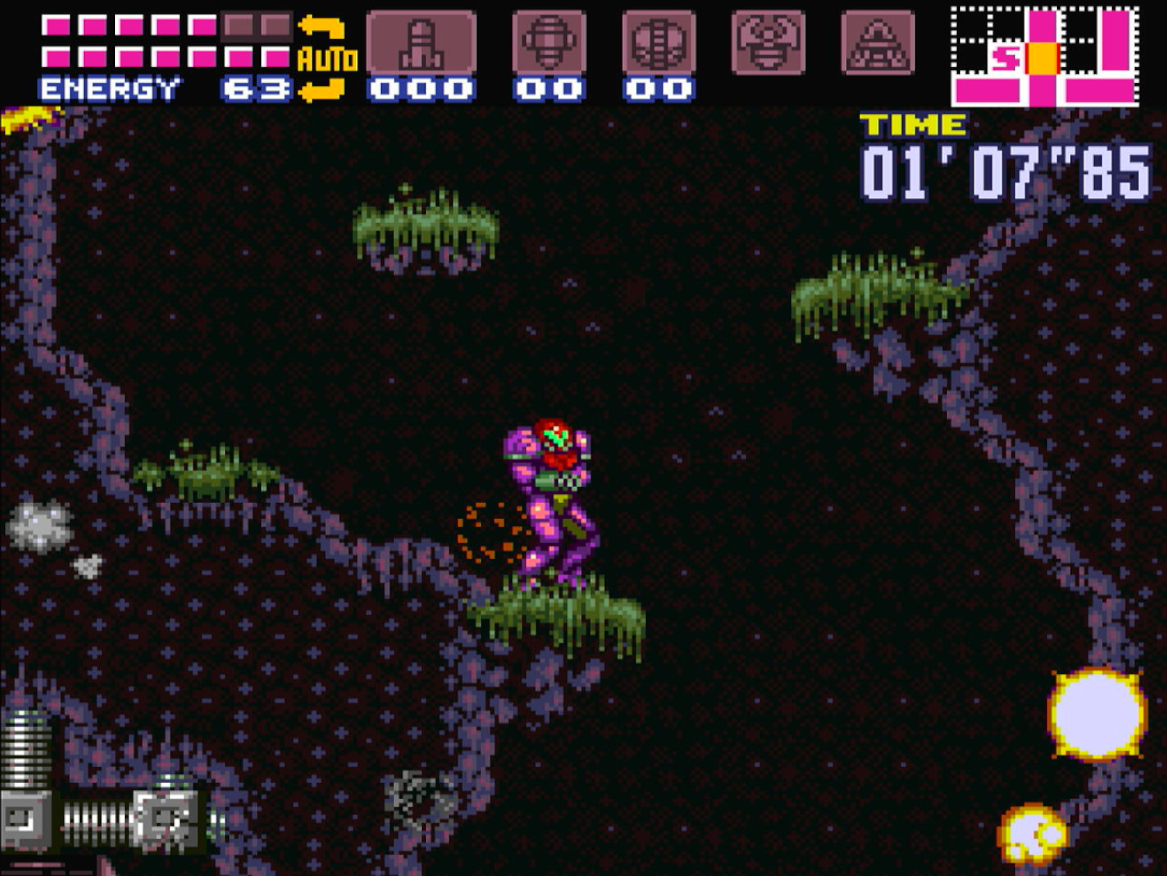
With Mother Brain defeated, it's time for one more dramatic escape sequence, and this one pulls out all the stops compared to the one from the first game. The first game was just climbing out of the vertical shaft behind Mother Brain's room, this one has you busting through shutter doors, plowing through space pirates, and physically running all the way back to your ship before time runs out.
And rather famously, on the way back to your ship, you can sneak into a side-room you've already been in, the room where you fought the first Torizo, and find the Dachora and Etecoons that assisted you. Should you free the way and allow them to escape, you get what you could in essence call the "canon ending". Yes, this side easter-egg is plot relevant for a future game.
What a game Super Metroid is. This is a game I quite often seen regarded as one of the best games of all time, let alone one of the best games on the Super NES, and it's not hard to see why. It hits the atmosphere just right, the music matches the mood of each area flawlessly, and it all packages into a game that feels satisfying to explore from having a secret hiding in just about every spot you can think of. It carries a more overt story without hijacking the pace with a ton of dialogue, letting the world itself speak on its own. It's so many hits and barely any misses.
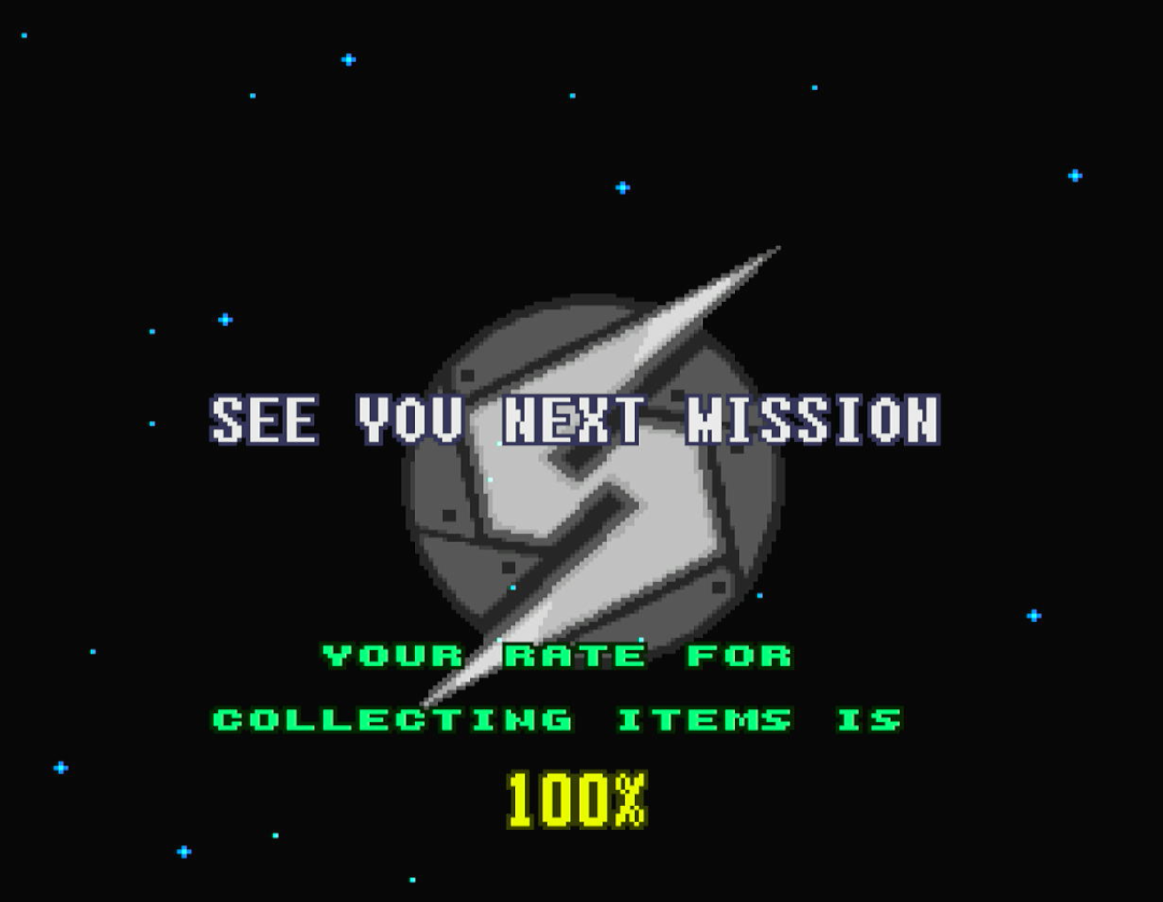
For as much of a Metroid Prime kid as I am, as I widely consider that subseries my home when it comes to Metroid, I find it hard to deny this is up there as one of the best Metroid games ever. Maybe not THE best, in my eyes, but a real dang close second. If nothing else, it's easily the best 2D Metroid in the series. Not to overhype a game but, it really is that good, with its one and only real asterisk being it definitely feels like an older game, control-wise. But even then, I find it easy to forgive when everything else goes so hard.
-------------------------------------------------------
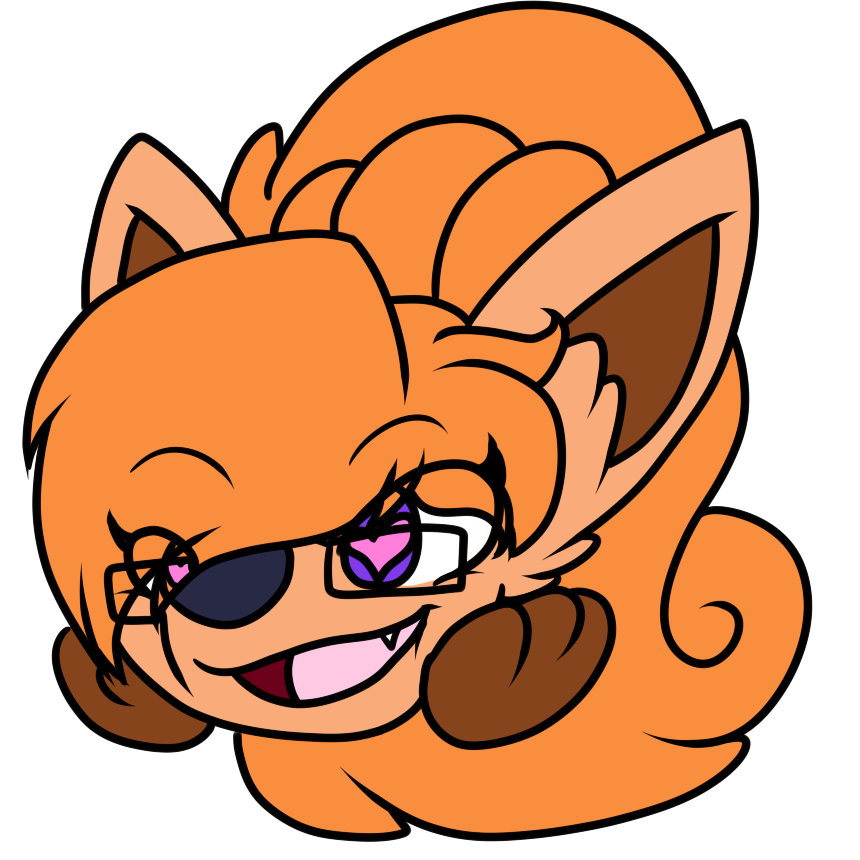 VIXI SCORE: 10/10
VIXI SCORE: 10/10
Stellar game. No notes. Aside from all this. Out of all of us I've said my piece the most. There is both a melancholy but also something worth celebrating in the fact that there will never QUITE be a game like this one. Many will try, but they'll never quite occupy the same space.
 LUNA SCORE: 10/10
LUNA SCORE: 10/10
Oh what I would give to experience this properly blind and not just vicariously through Vixi's memories of her blind run. Maybe its not a hot take to adore this game but y'know. Sometimes a game has the reputation it has for good reason.
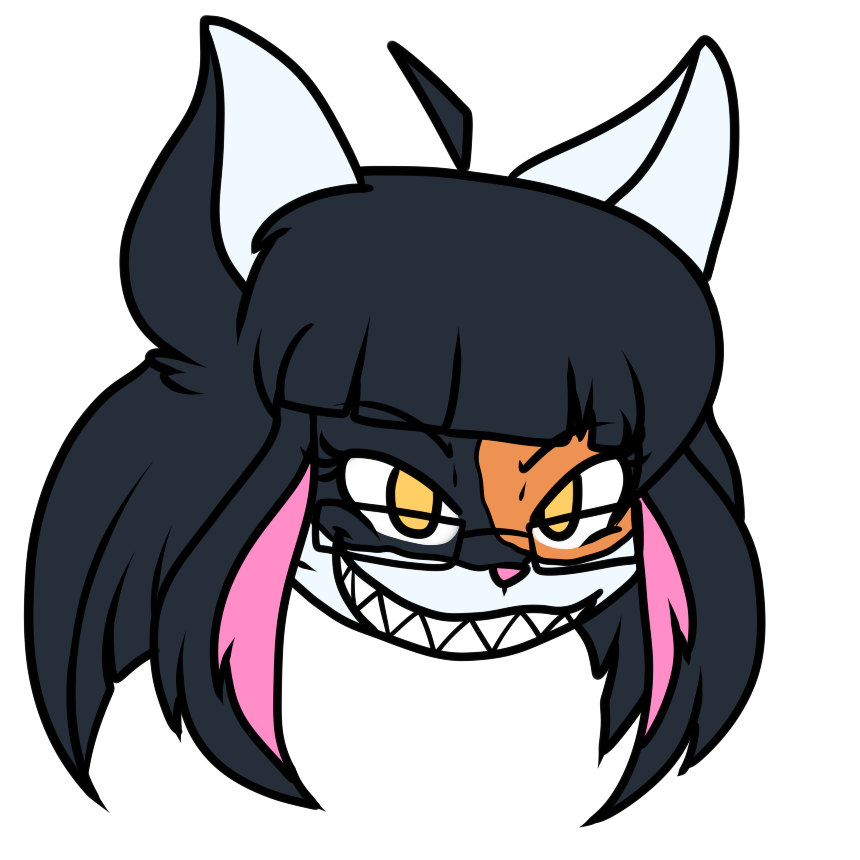 JINX SCORE: 9.5/10
JINX SCORE: 9.5/10
only slightly hard to clonk into my mindsphere when every 2d metroid after this one feels at least a little more silky smooth to control. but that's like, the one thing holding this game from being perfect to me.
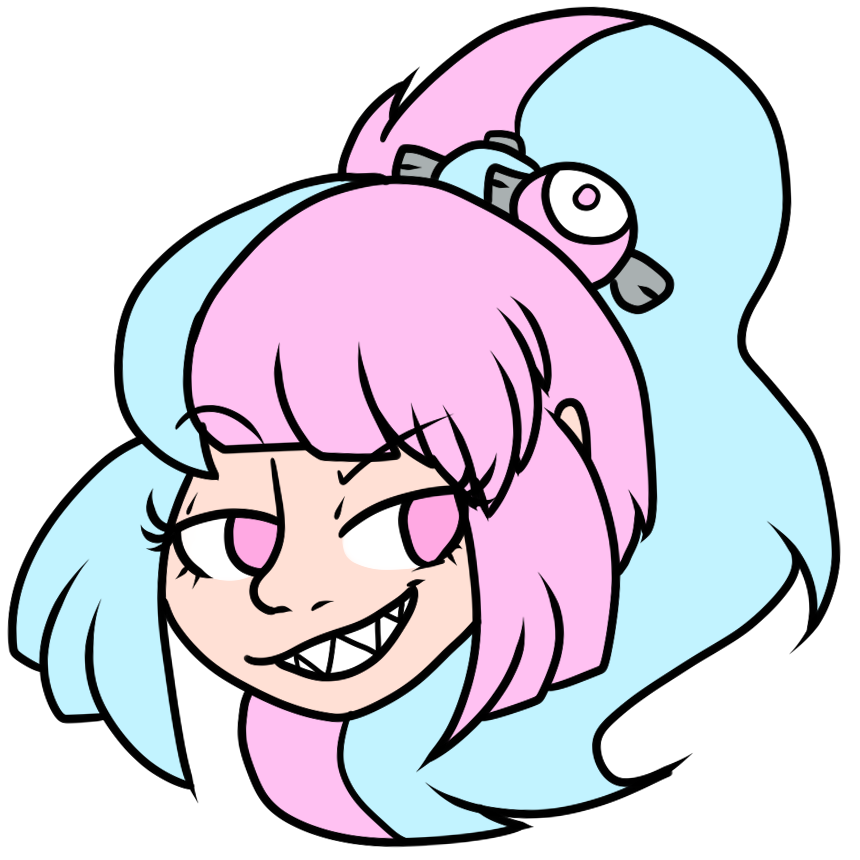 IONO SCORE: 8/10
IONO SCORE: 8/10
Not a fan of Samus feeling like a flying brick, but I see why everyone else loves this game so much. Maybe the games after this just make me feel spoiled. Sorry fellas, this one is merely "pretty dang good" for me.
 CELESTE SCORE: 10/10
CELESTE SCORE: 10/10
Iono will be launched into space following that comment.
For real though, one of the best games to ever do it. It never stops being a delight to play, apart from one or two pickups that are the mildest of pains to get and Samus' stiffness making bosses feel a lil stat-check-y. The good just way outweighs any of its problems.
OVERALL SCORE: 47.5/50

Coming up next on The Last Metroid: Metroid officially makes its jump to 3D! Just not on the console most other Nintendo series did.